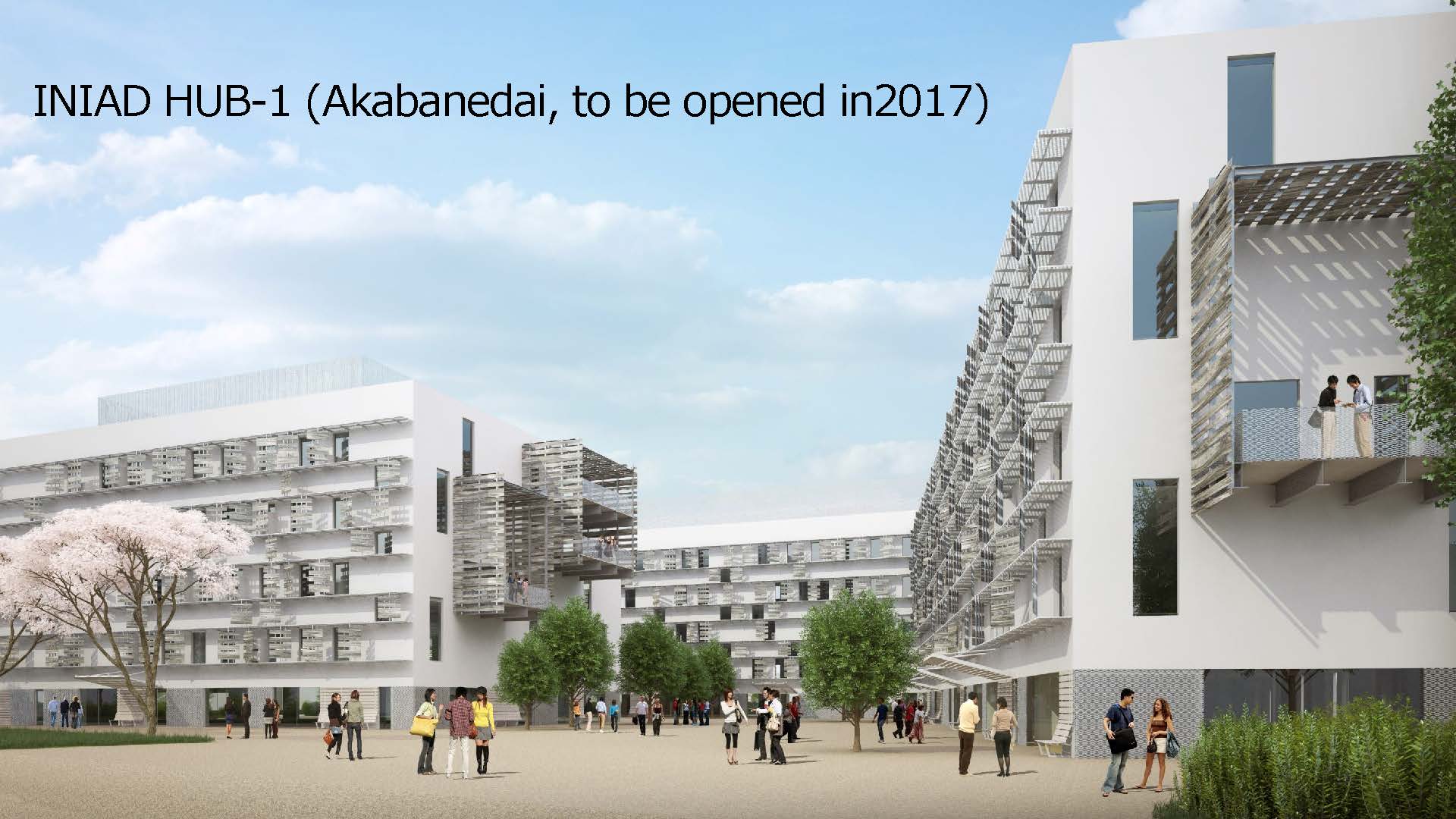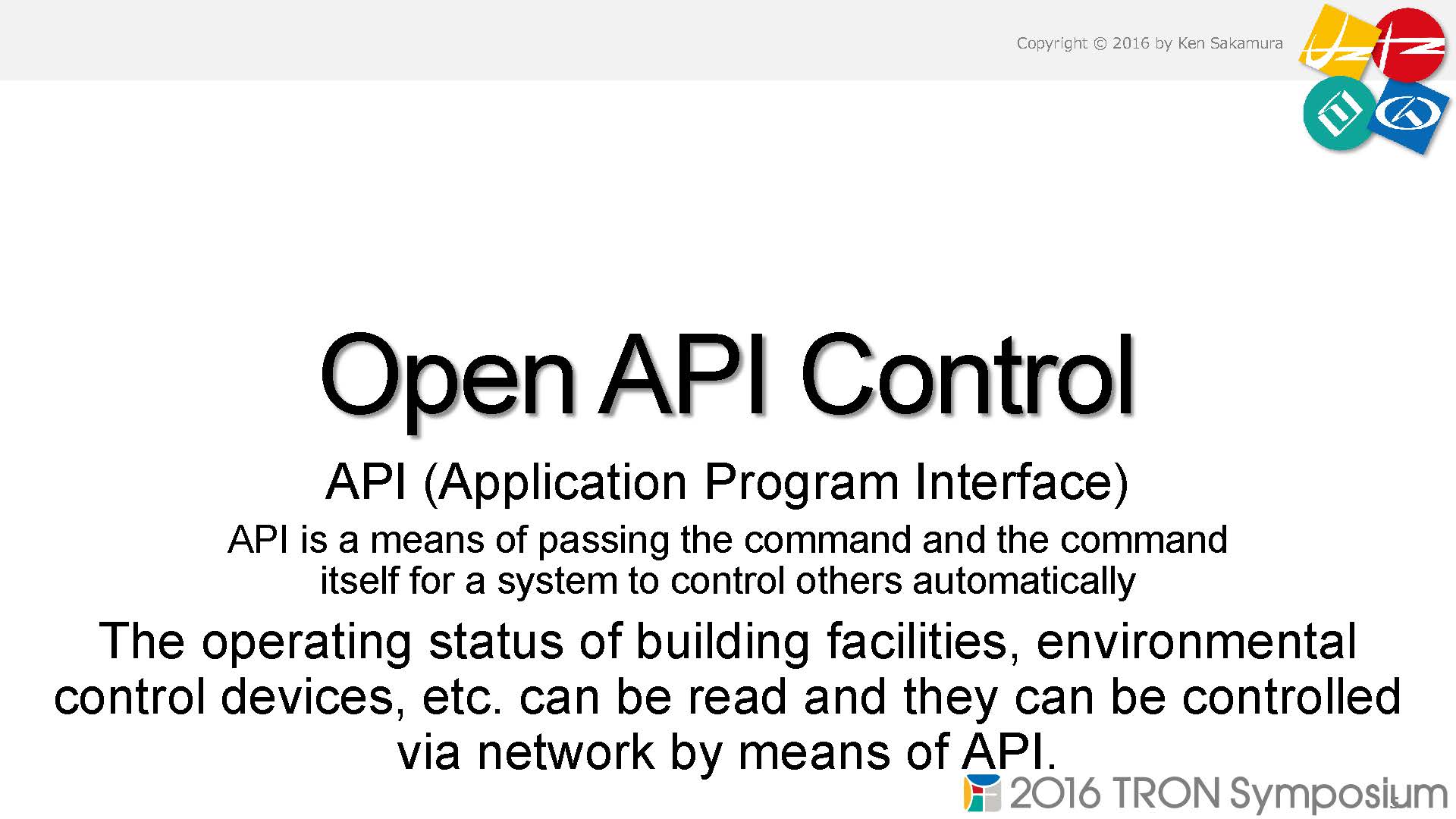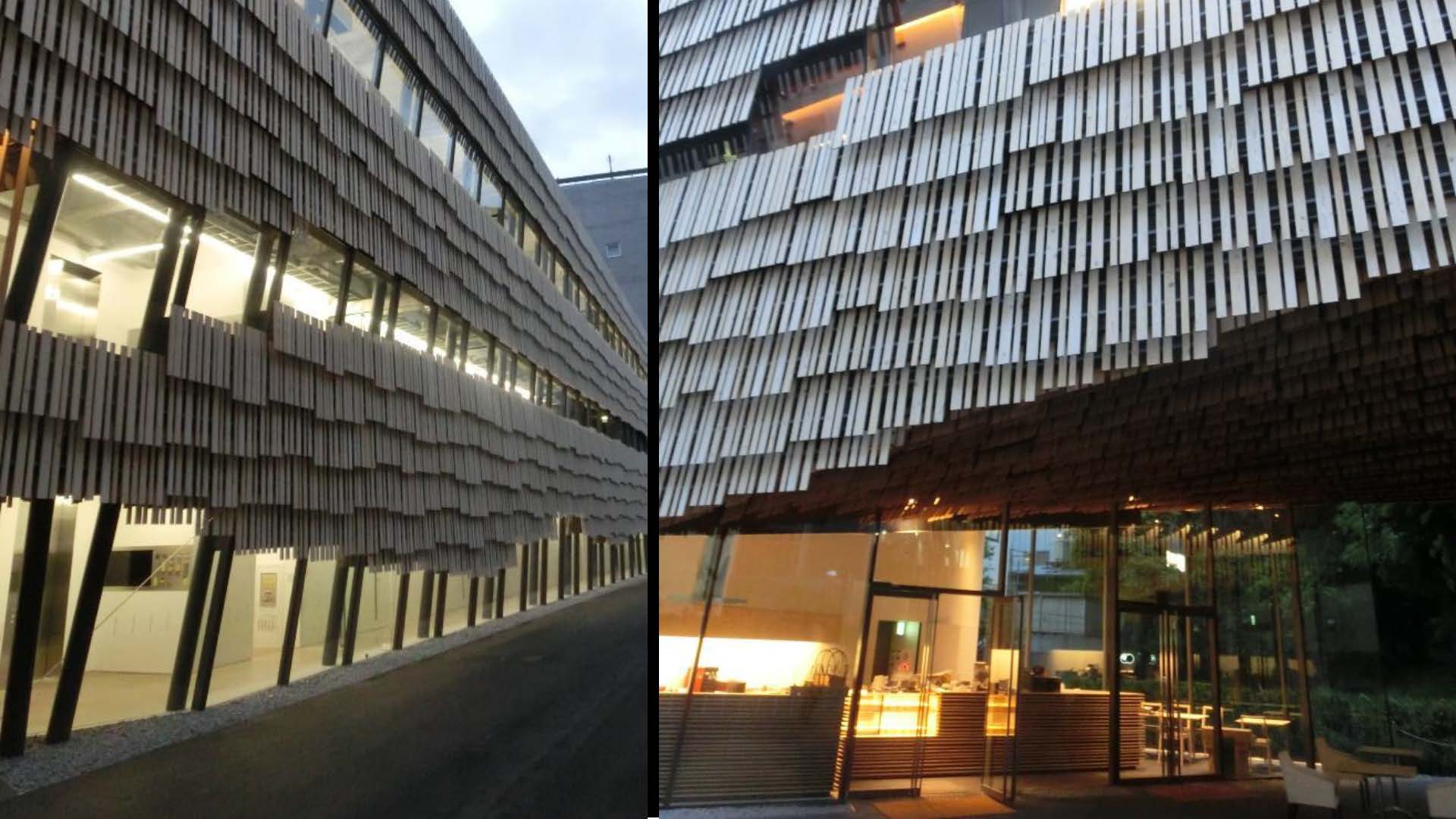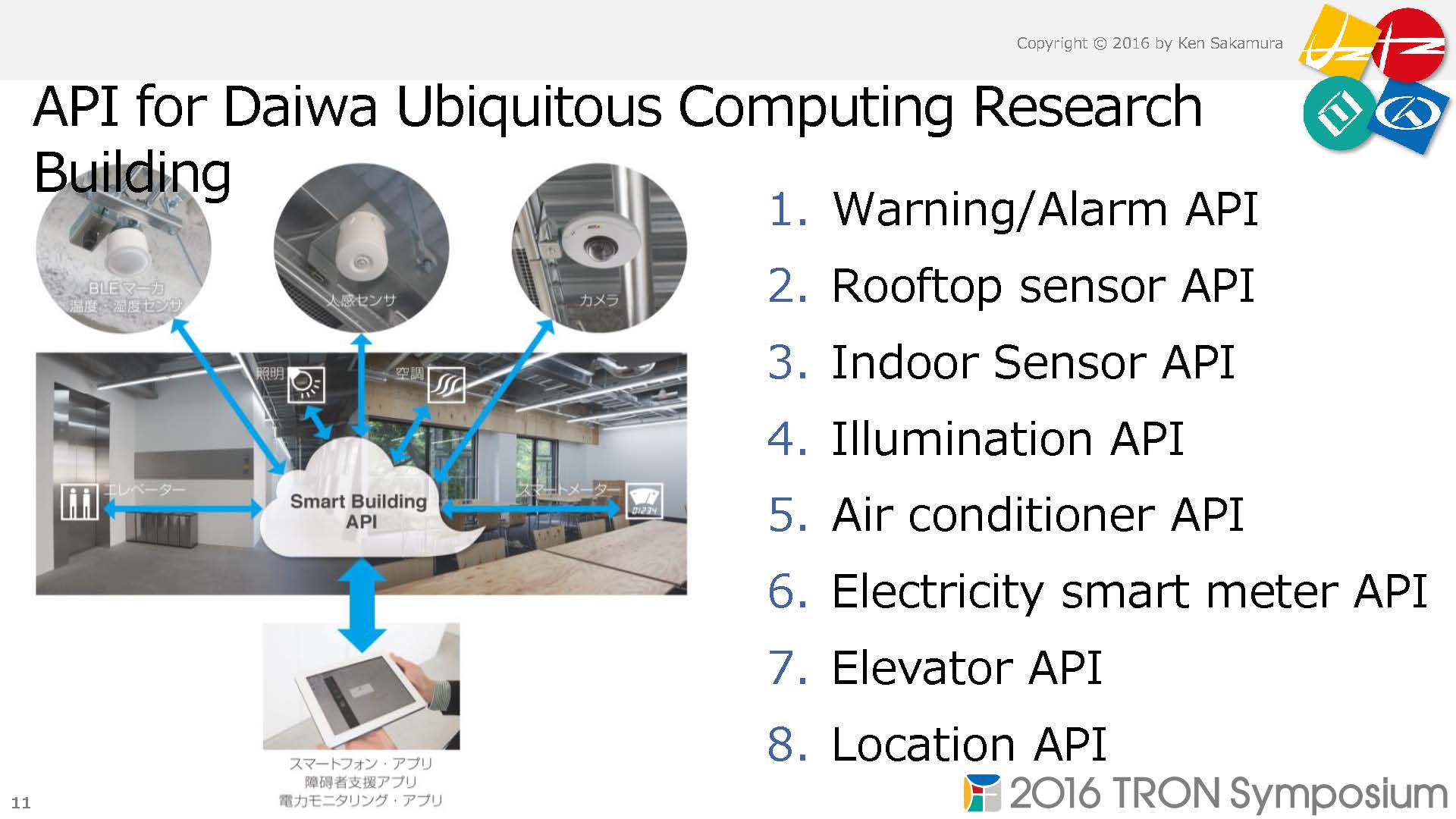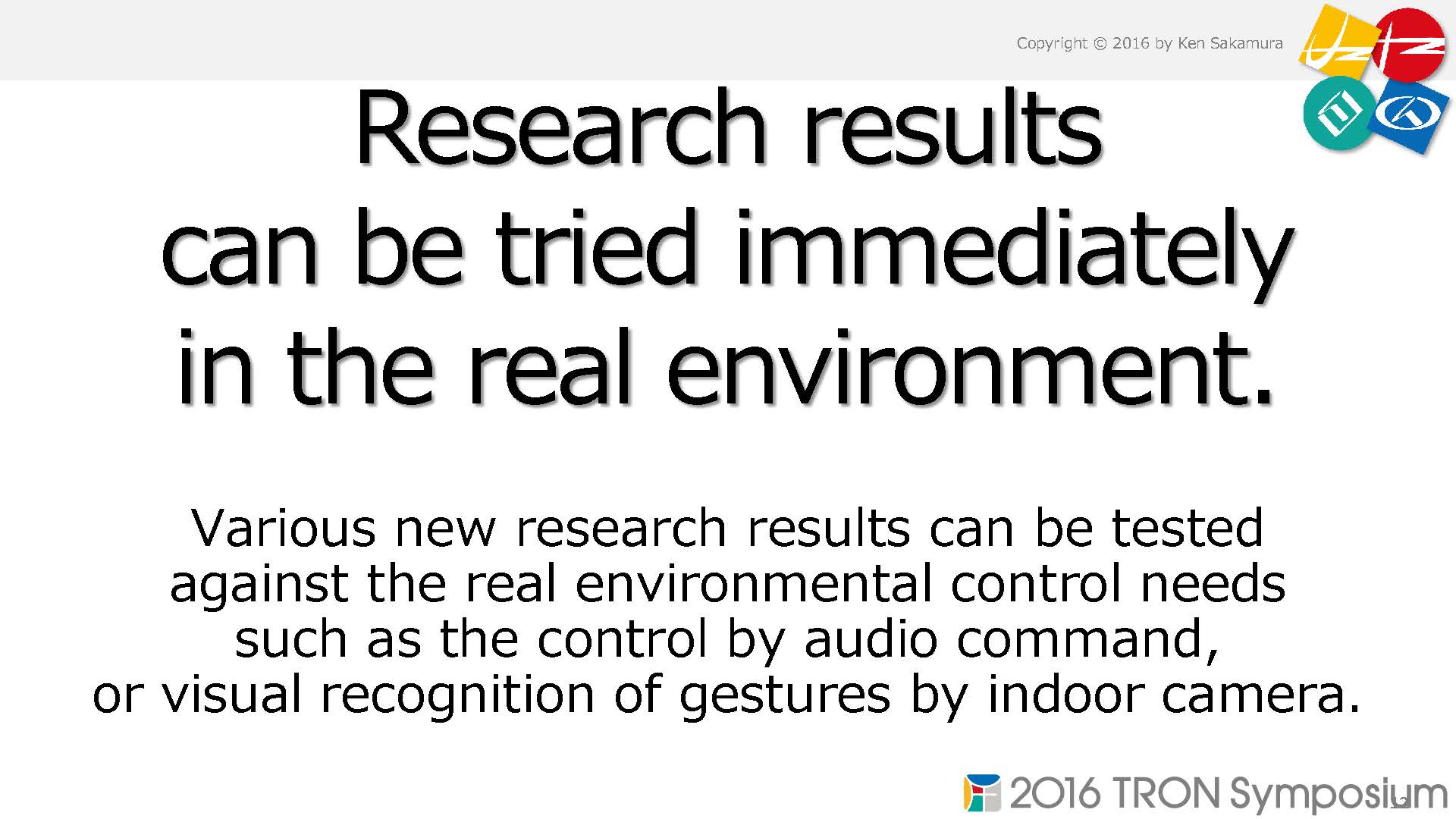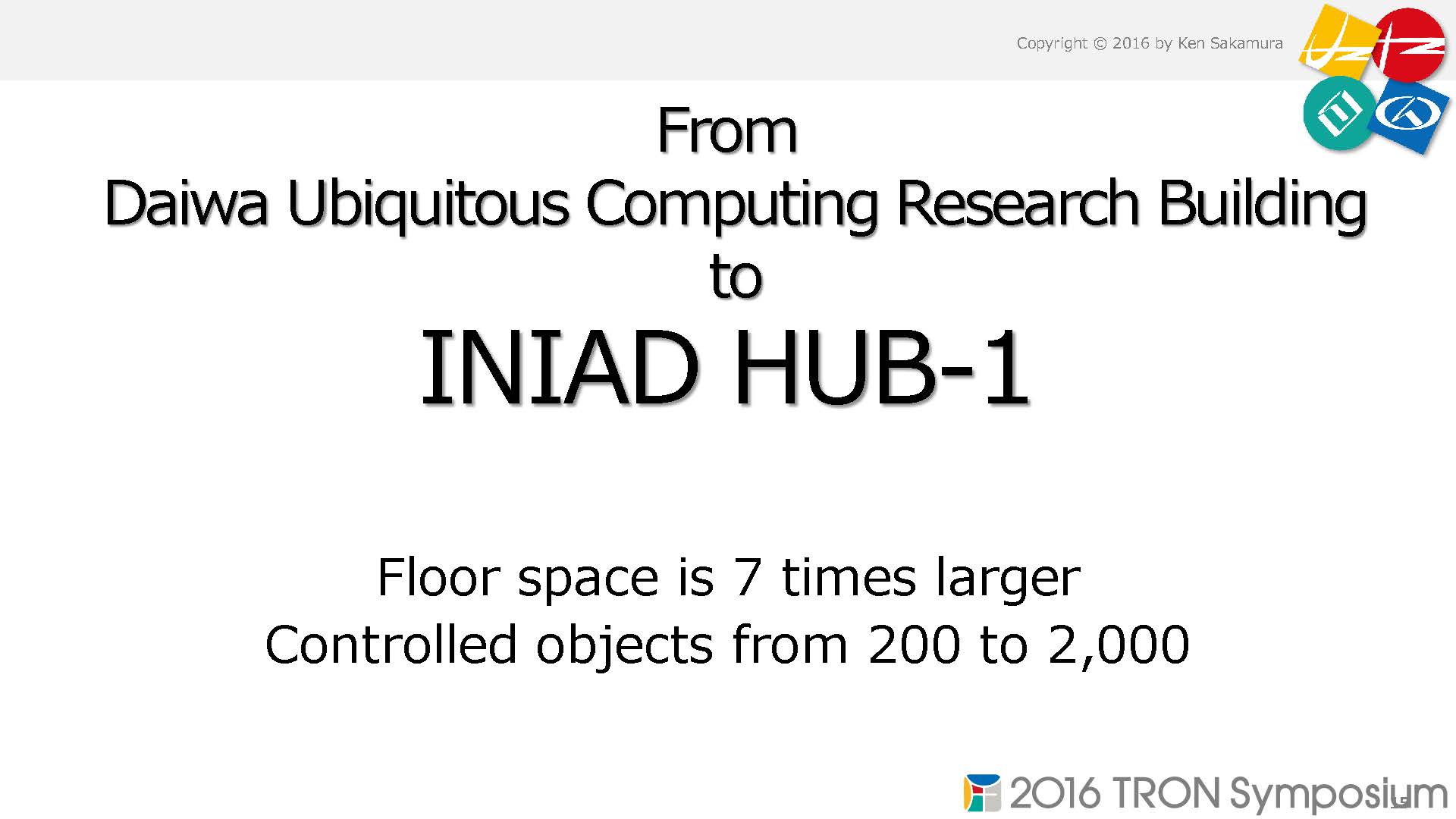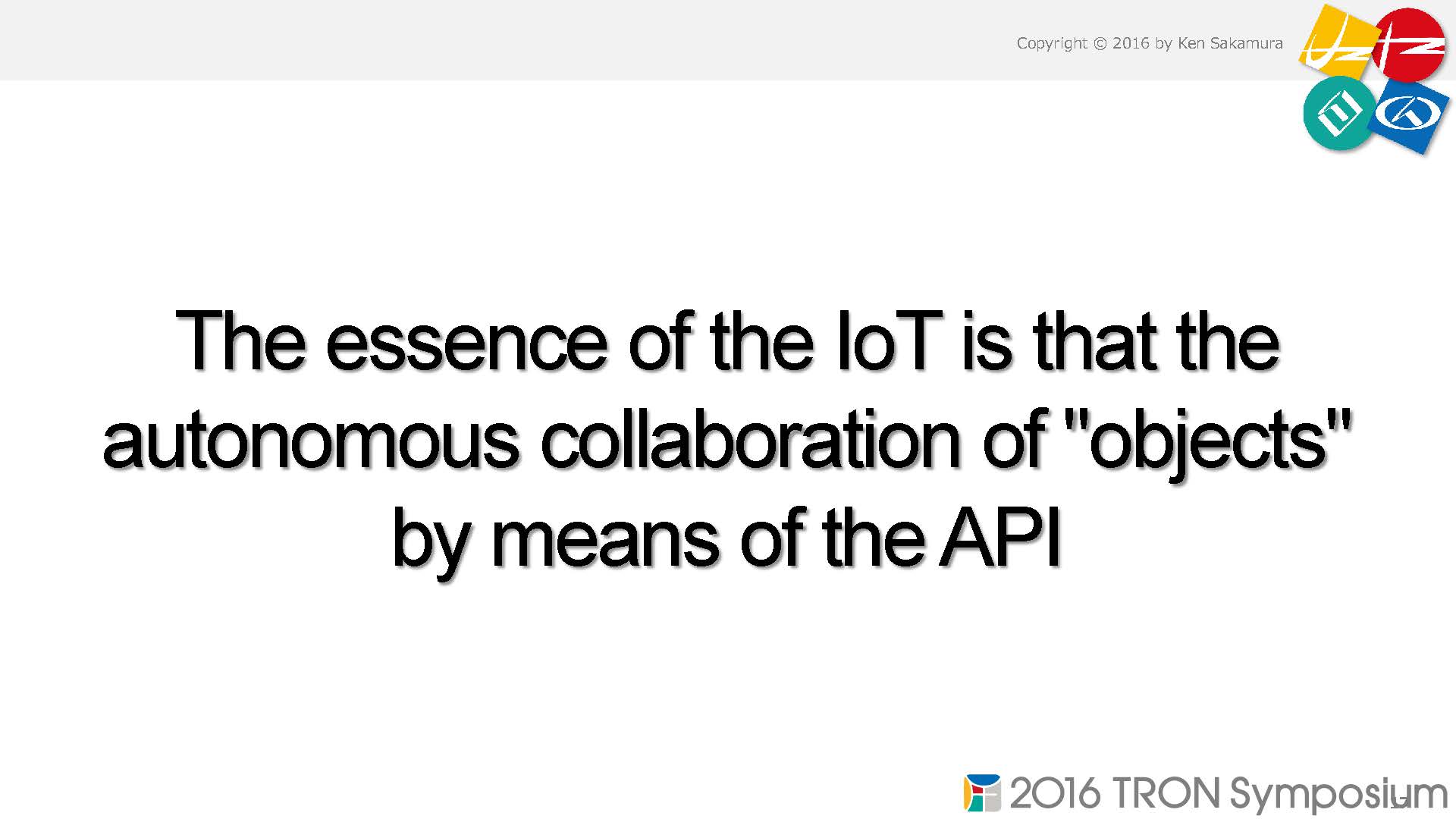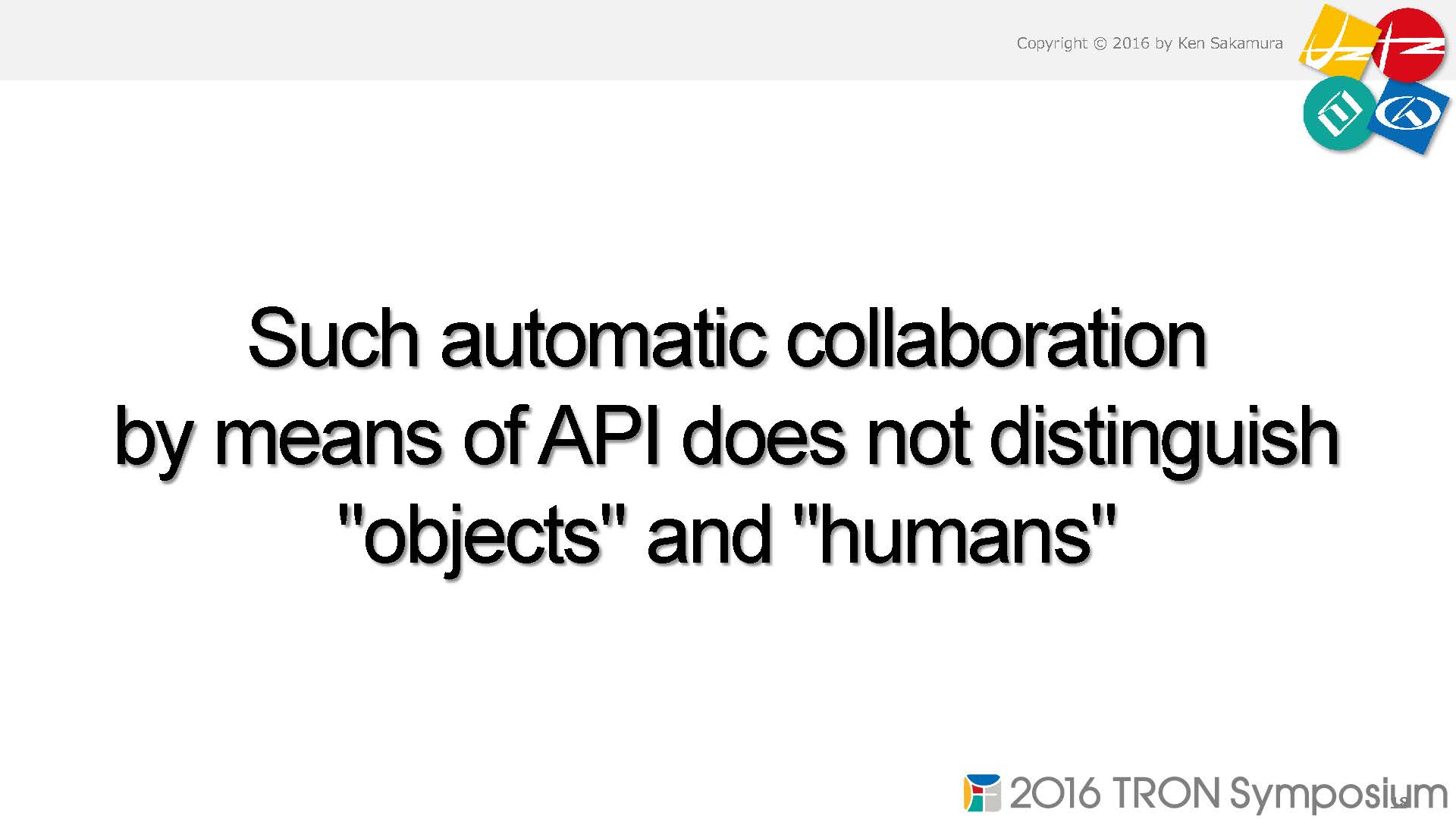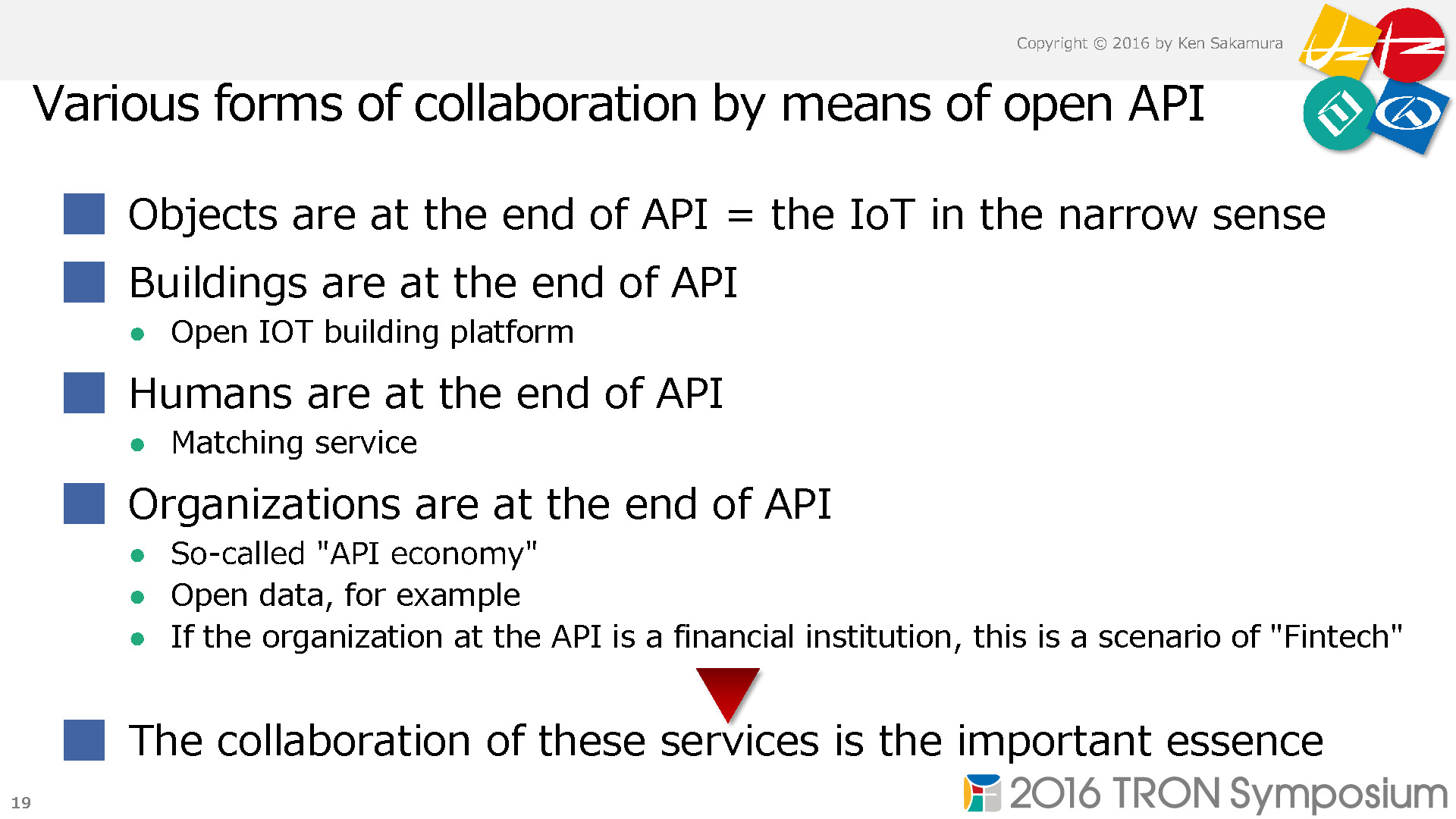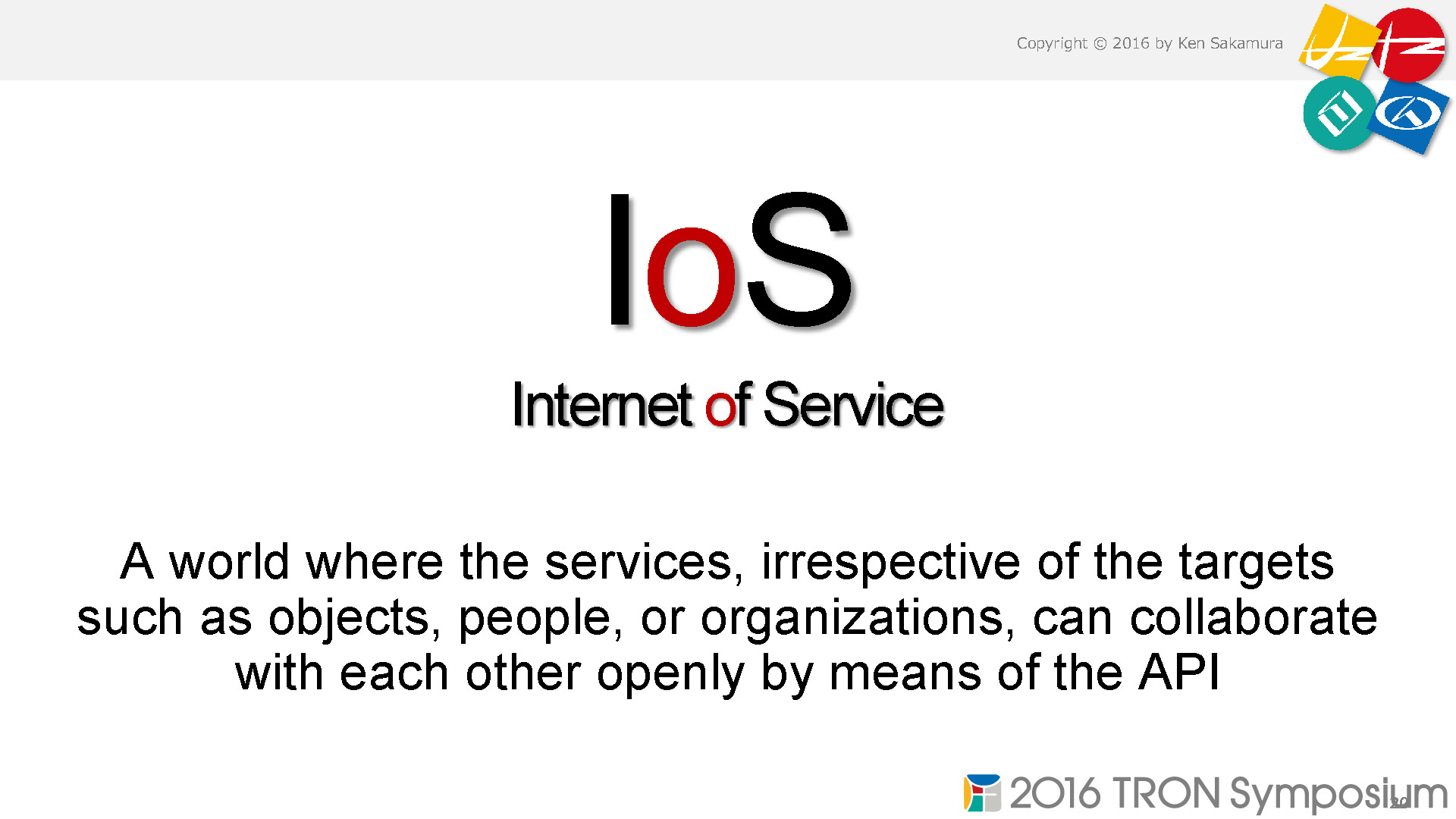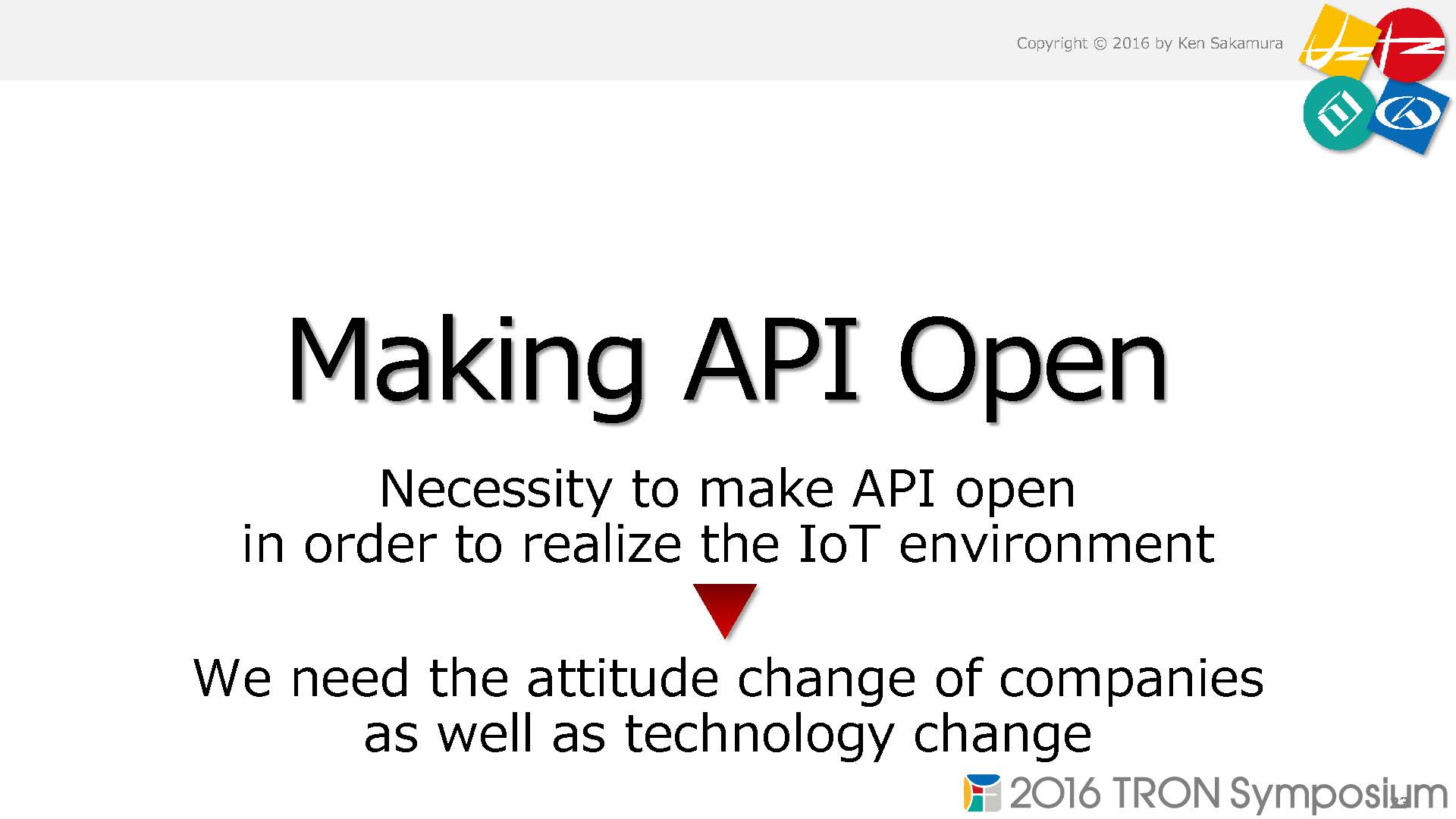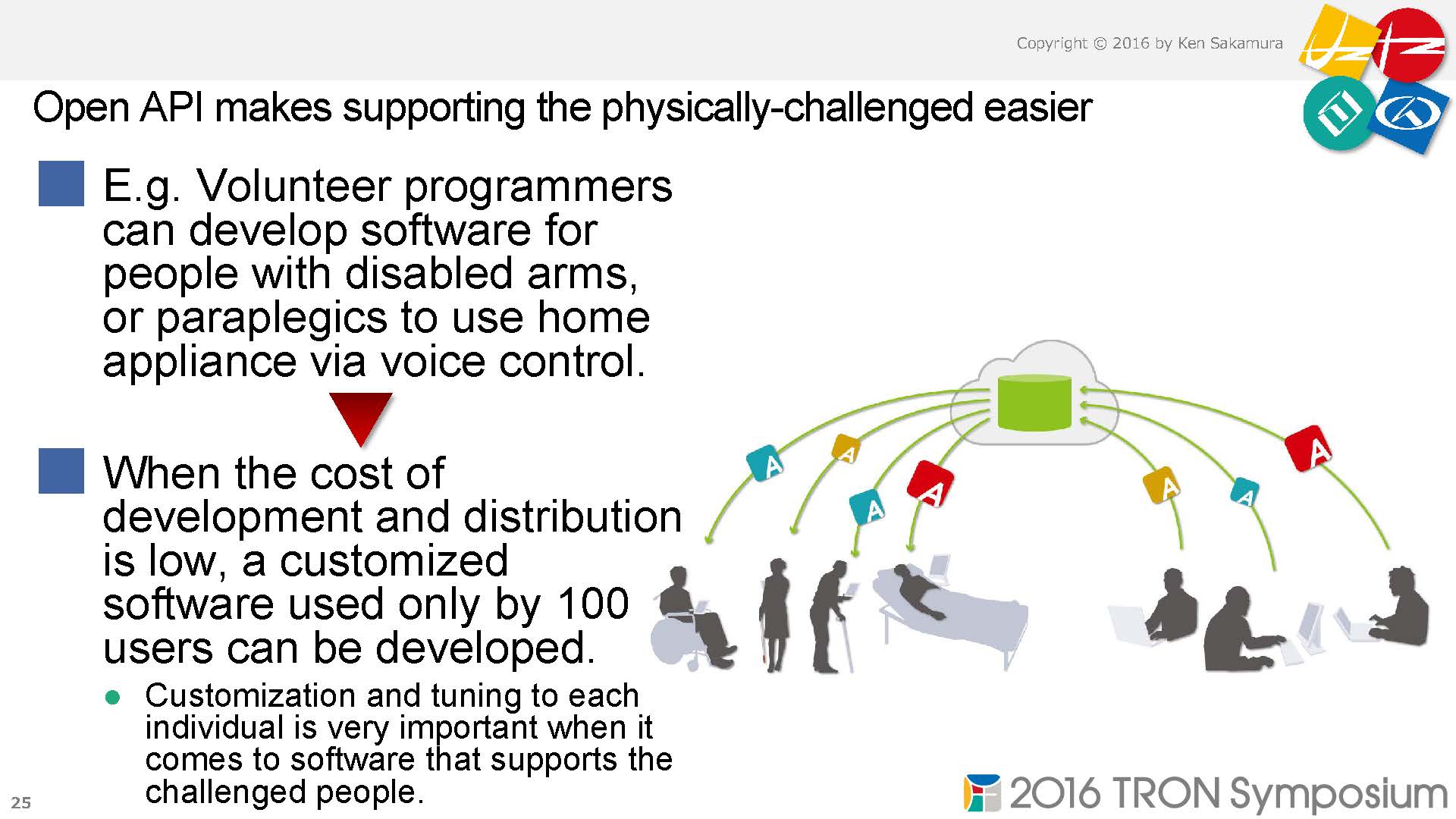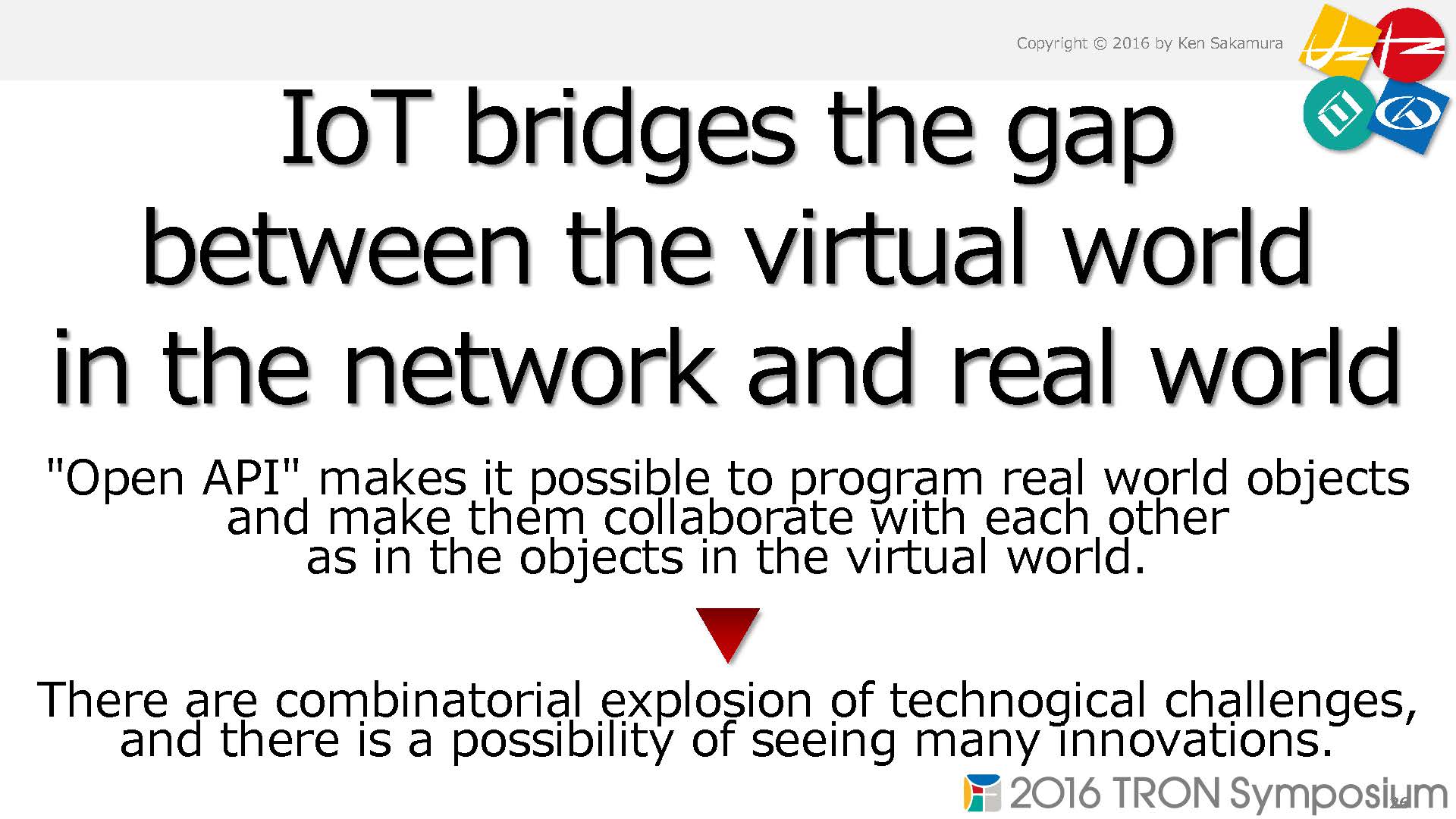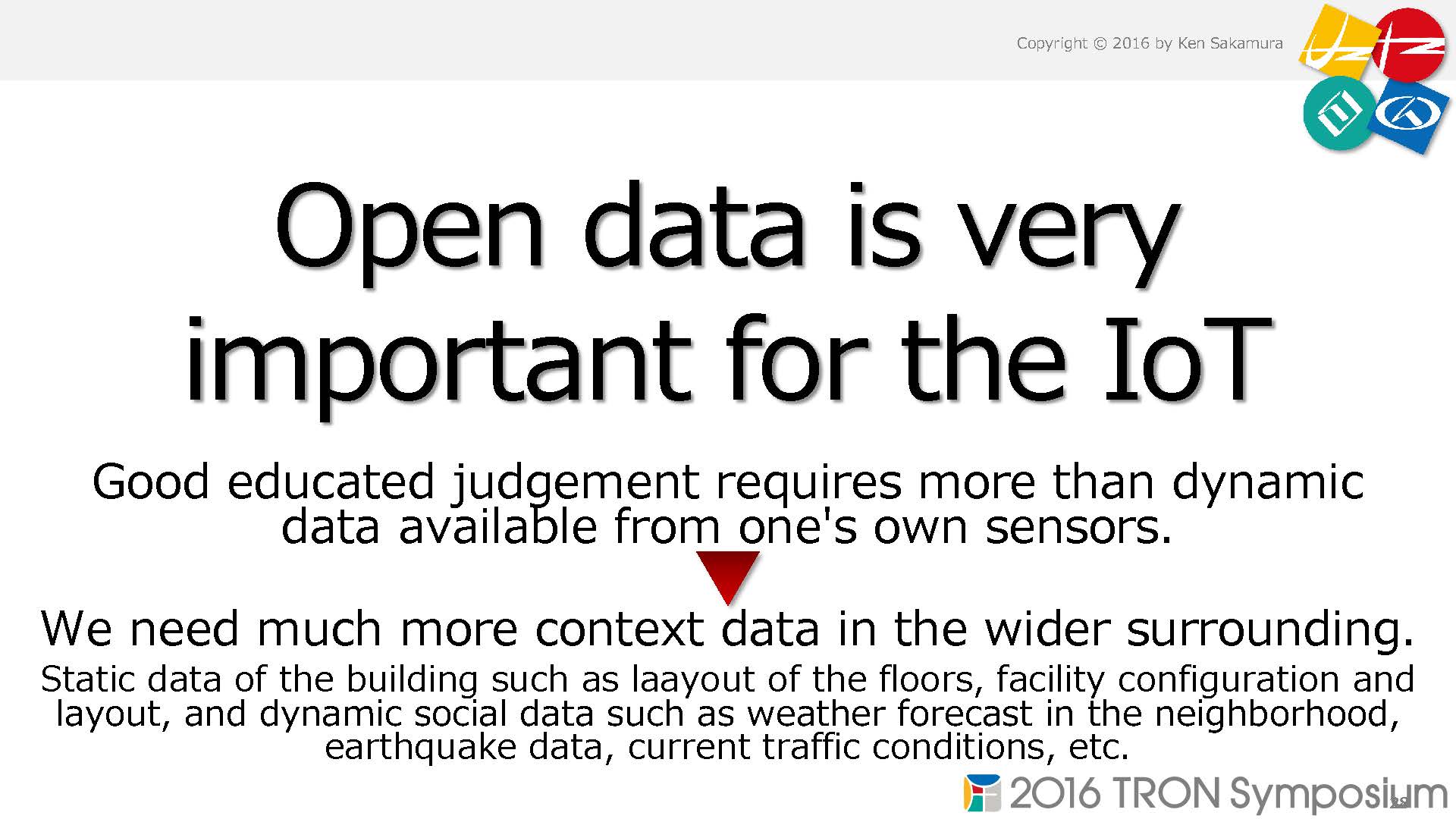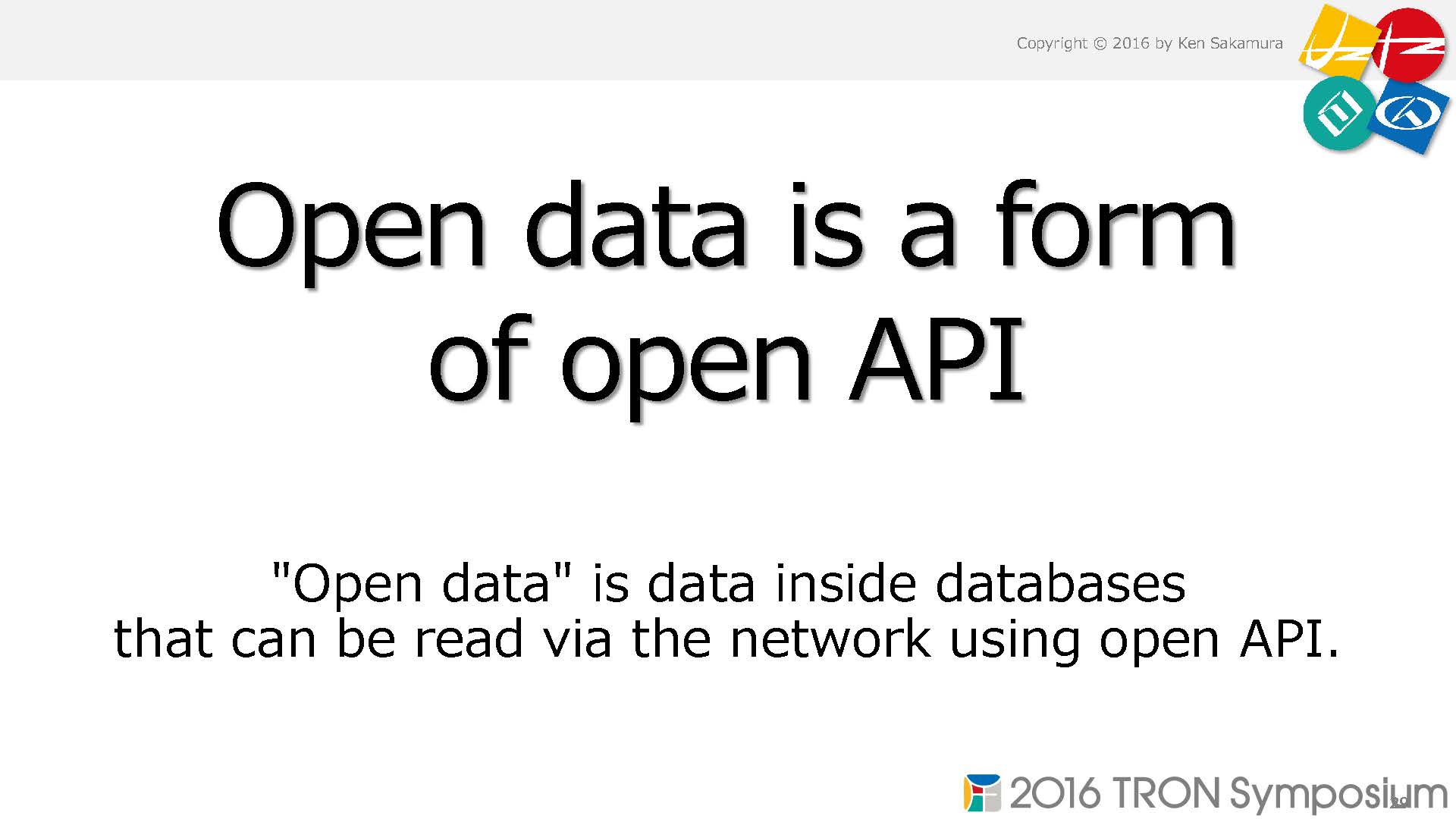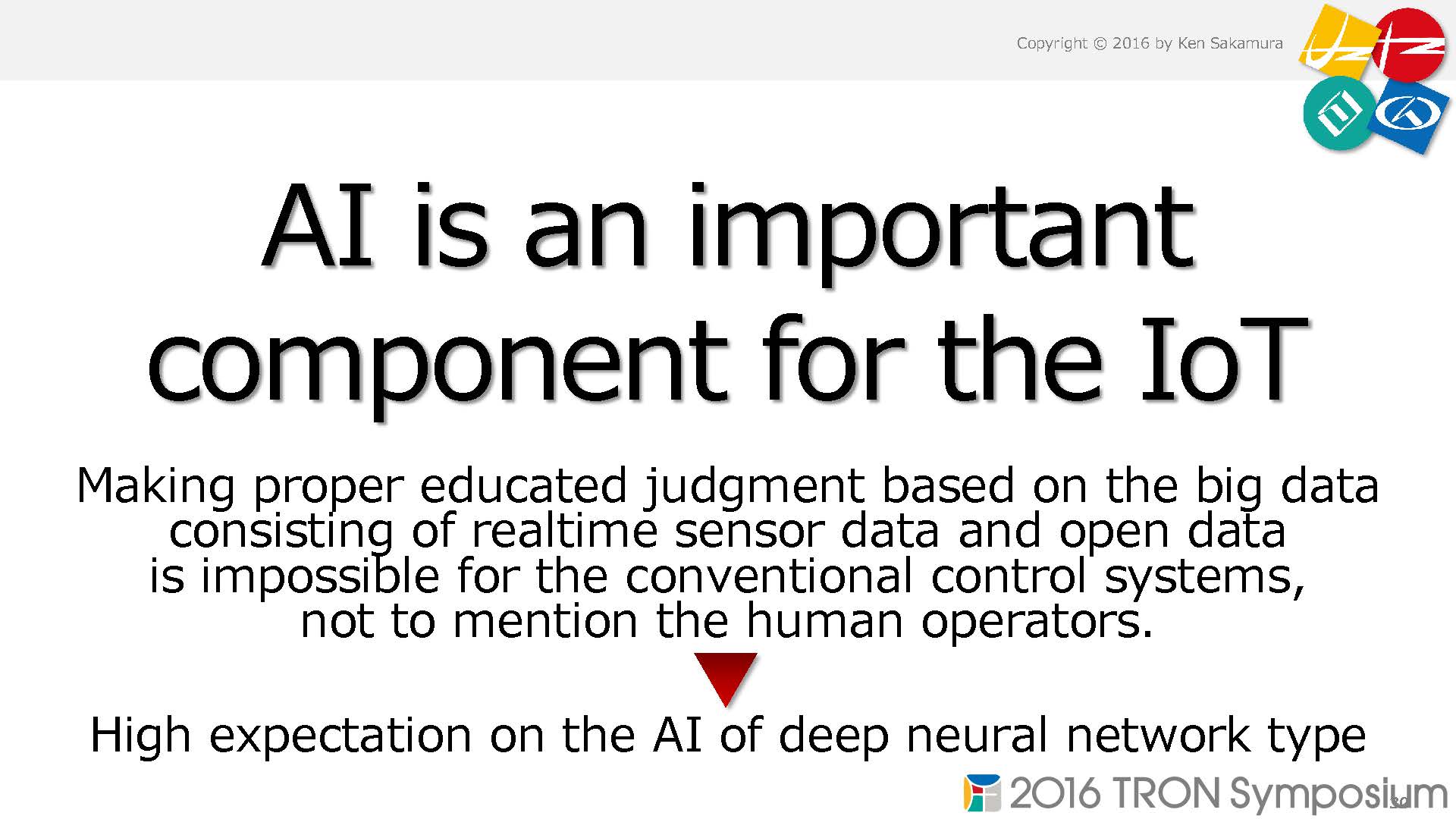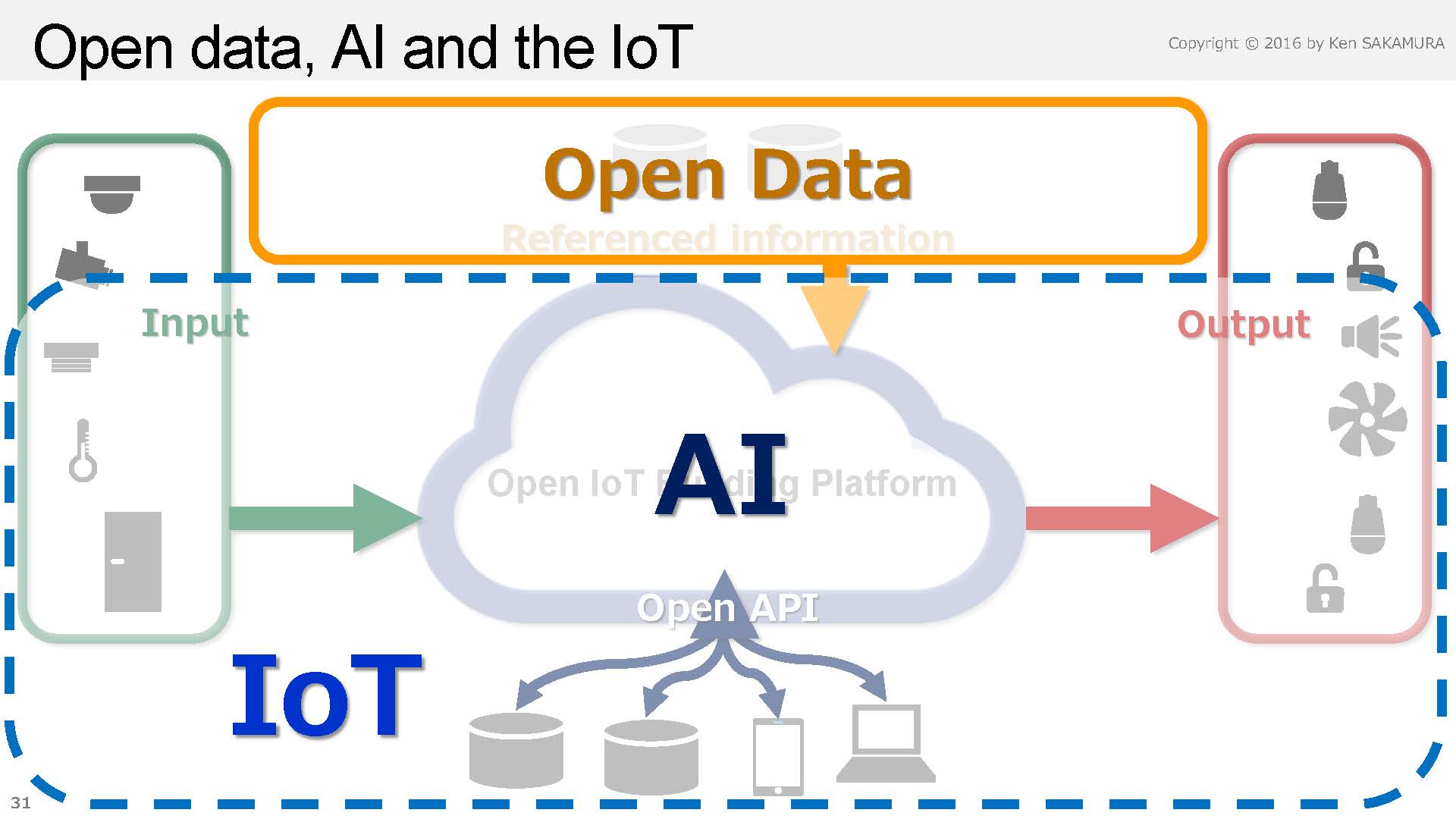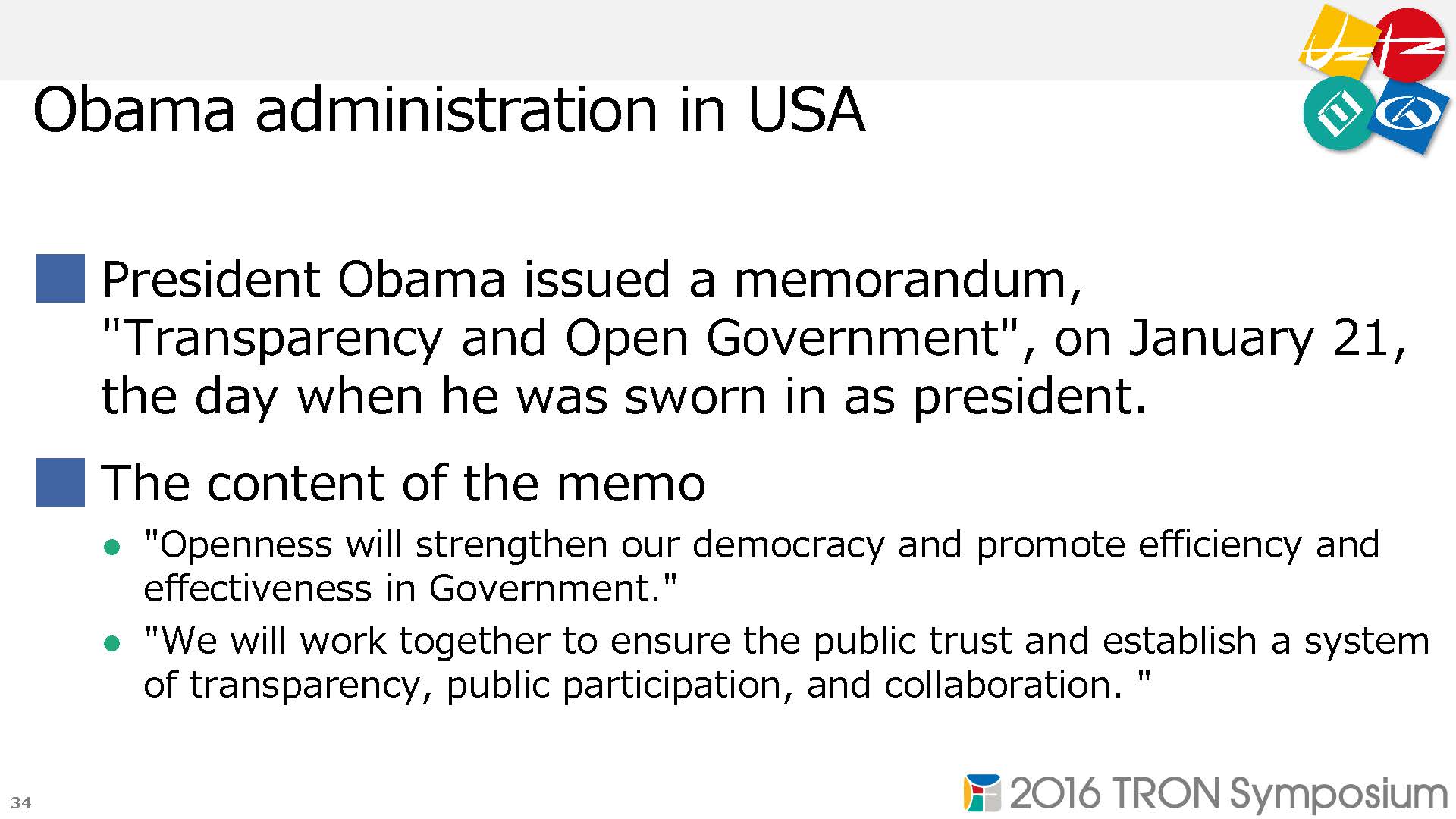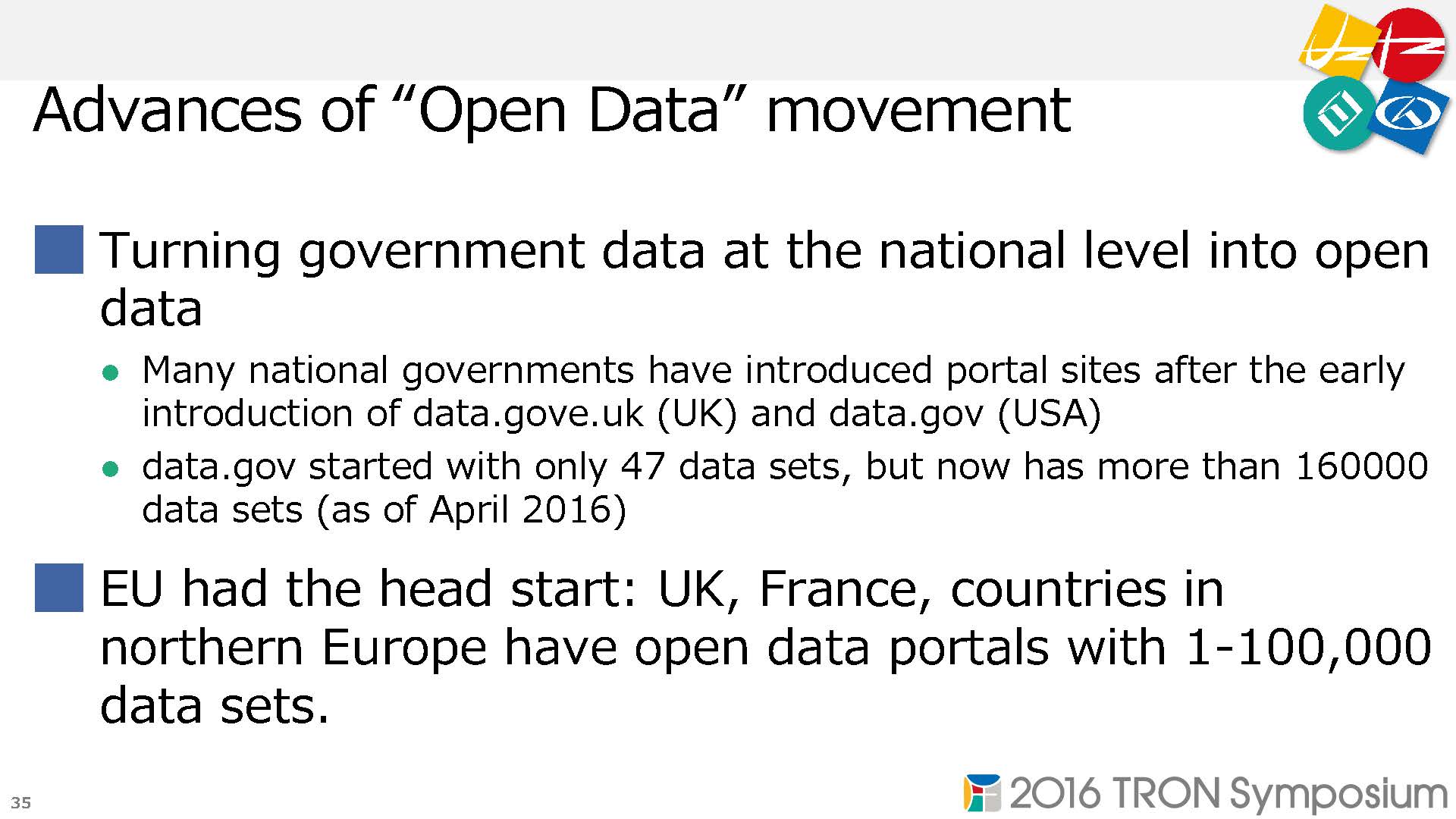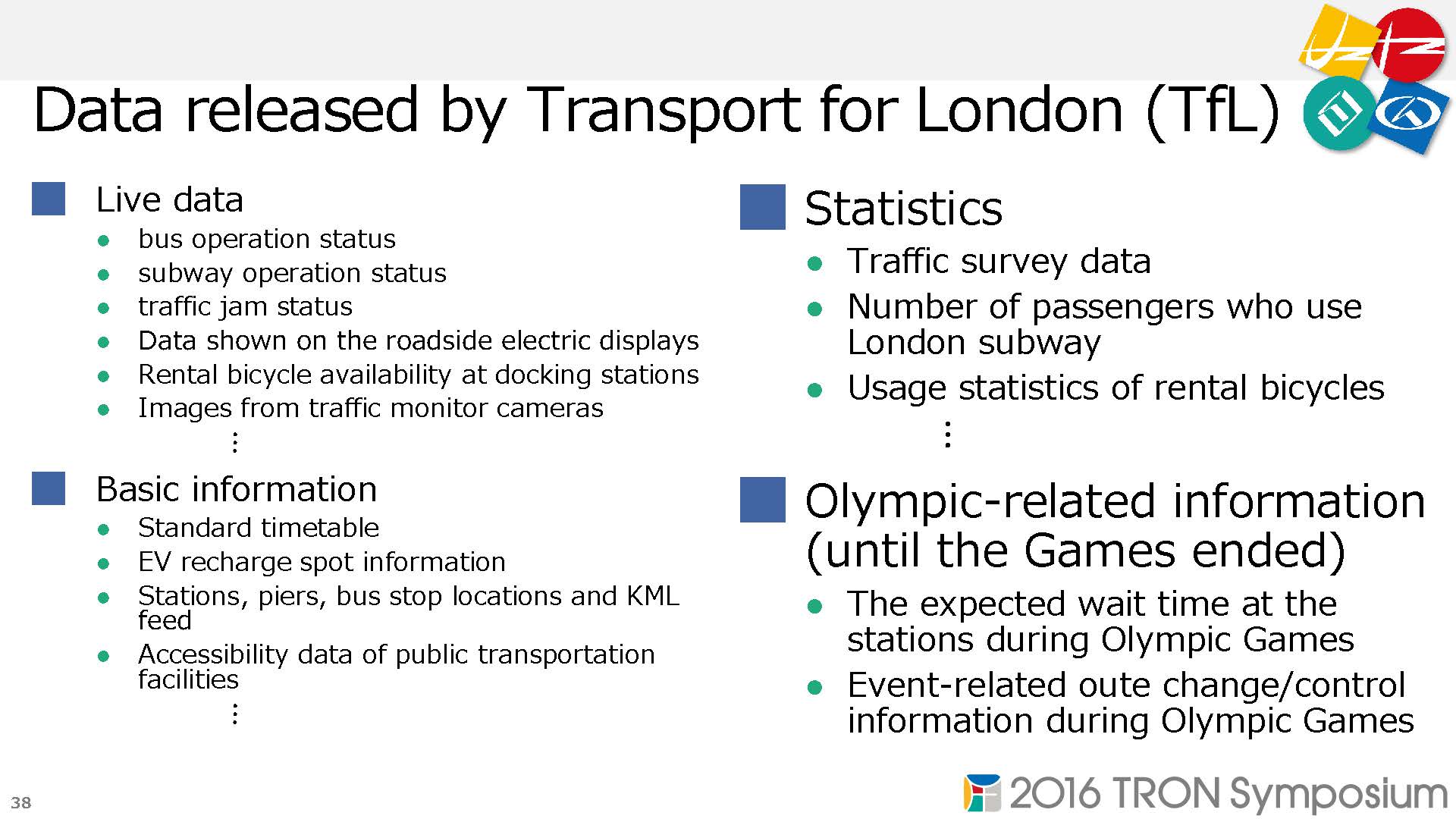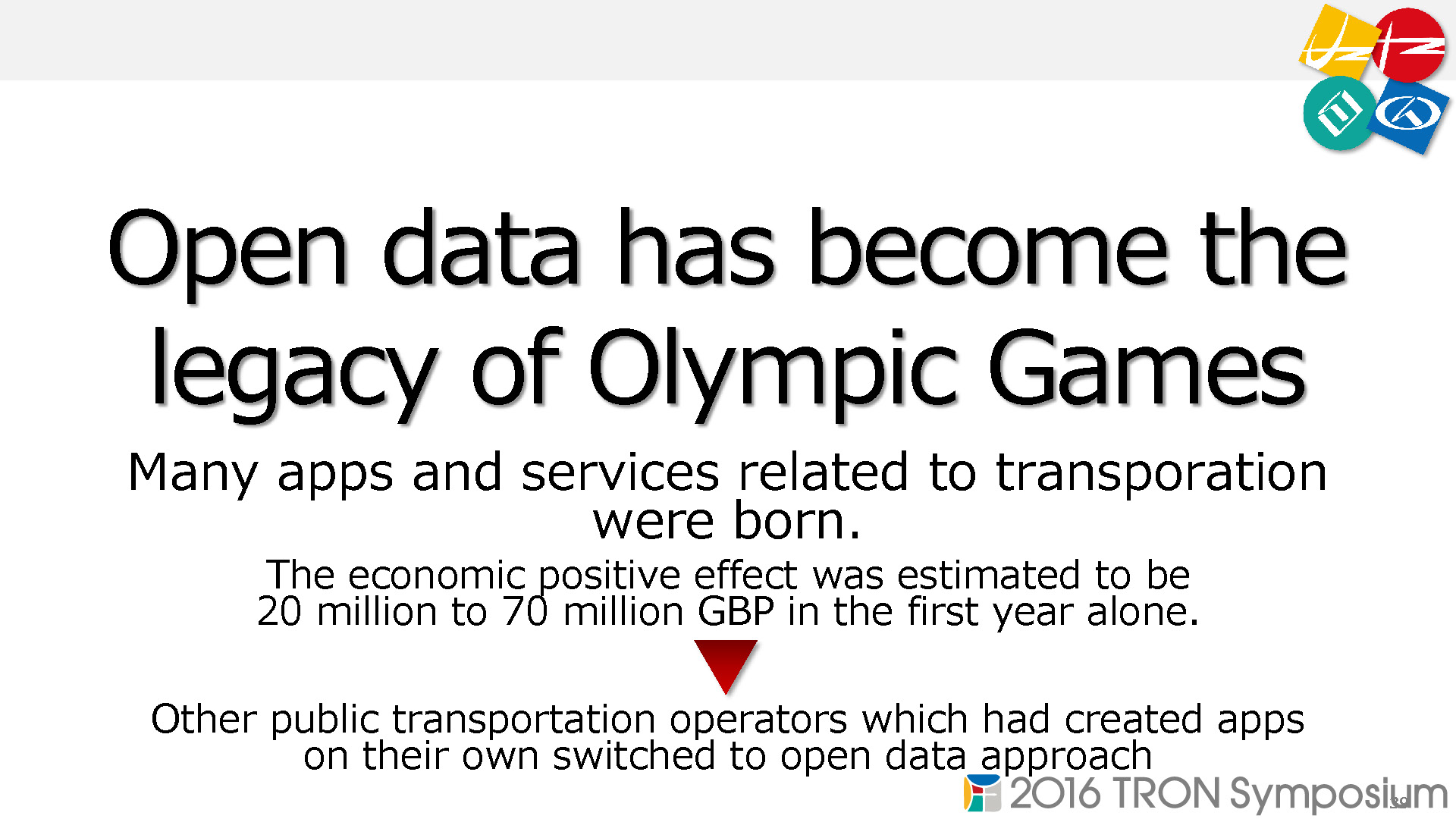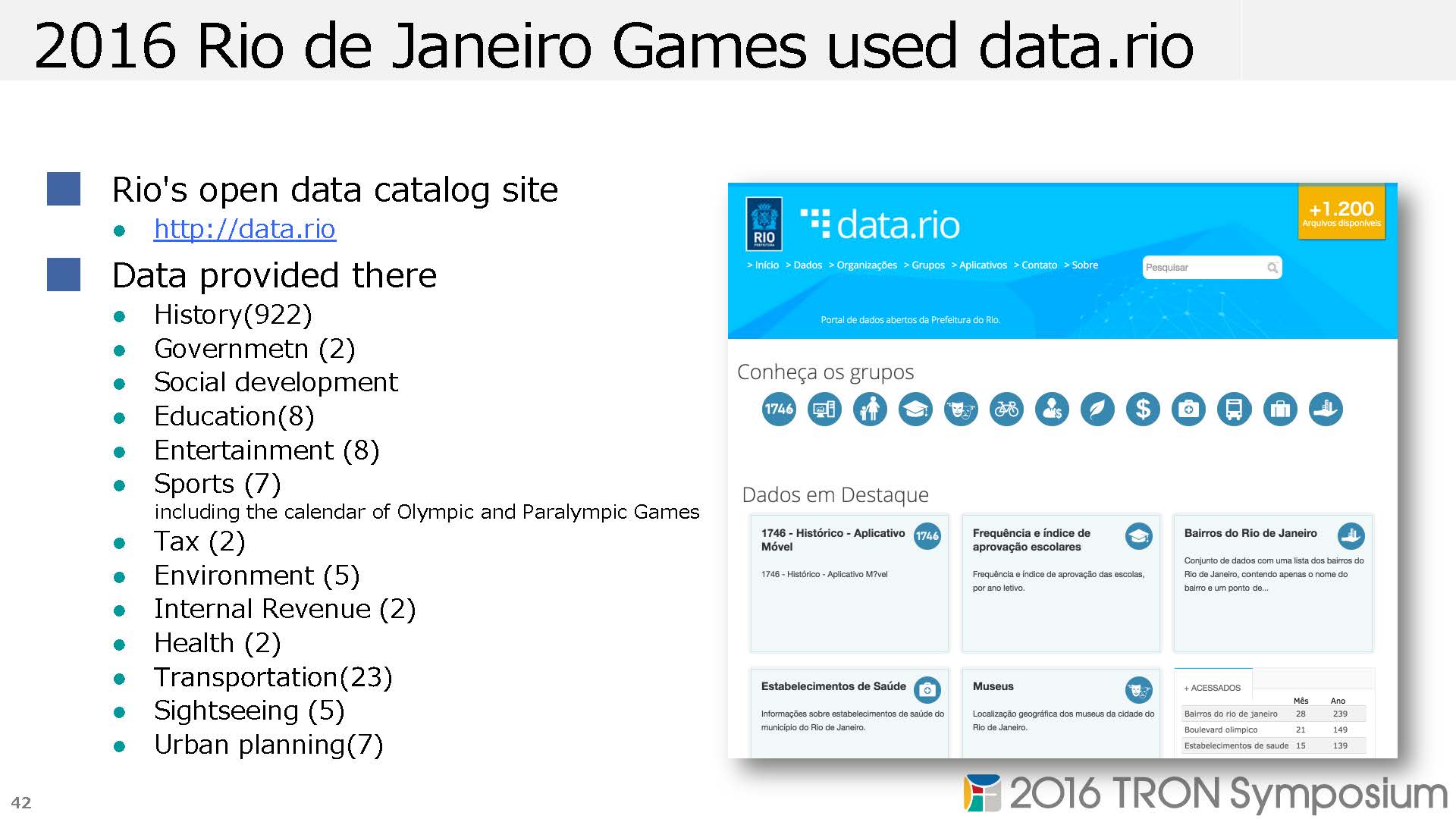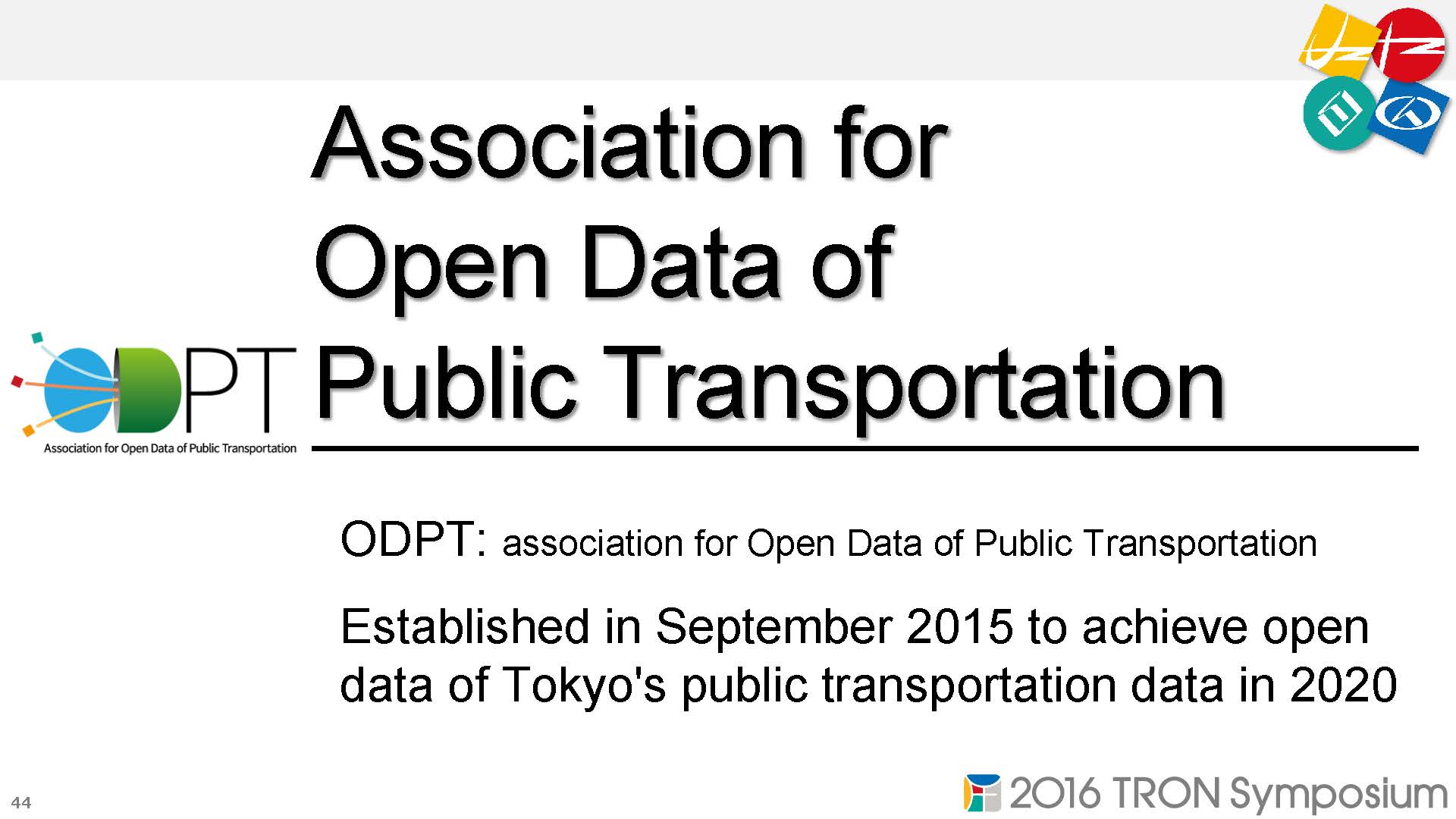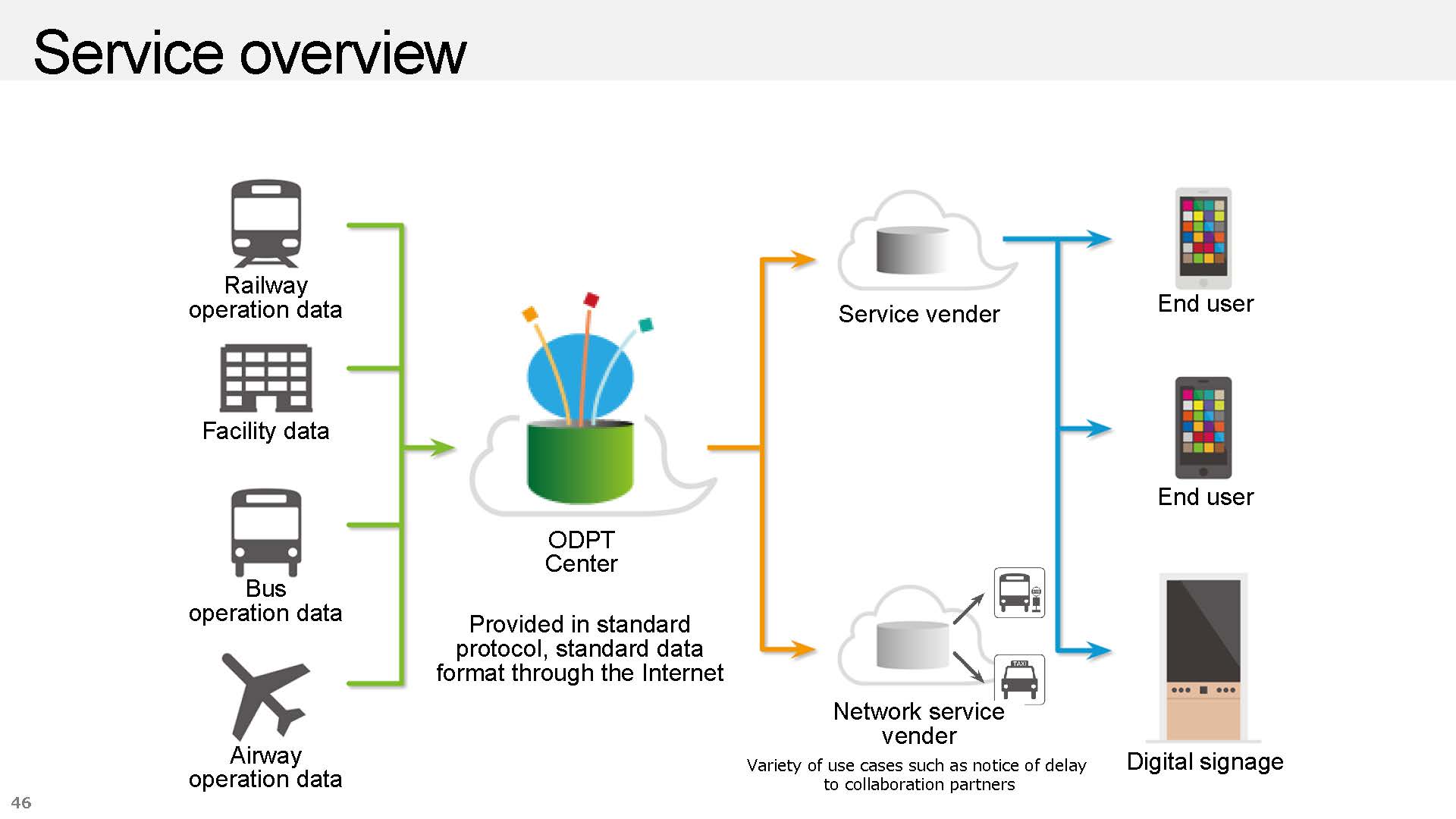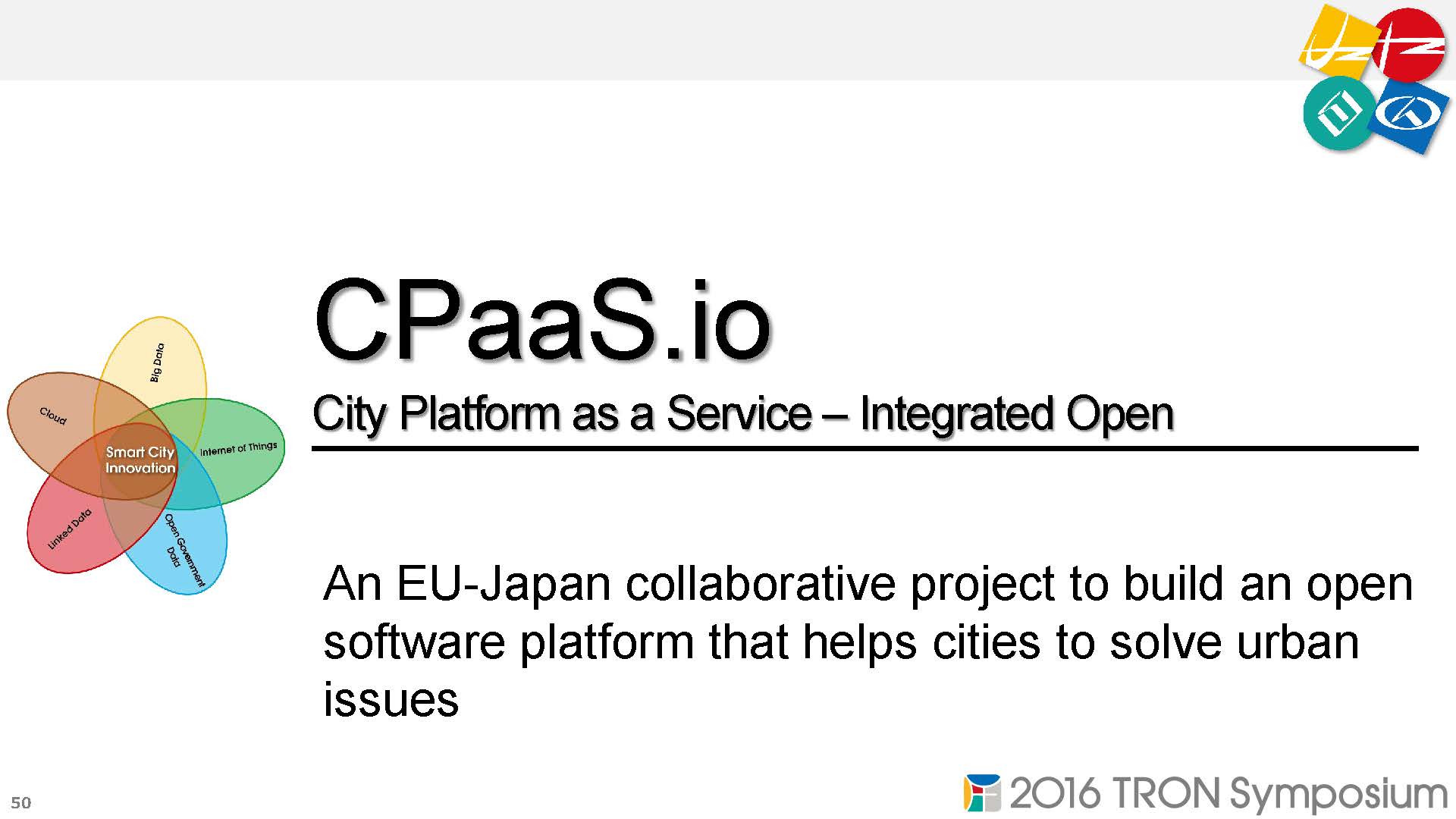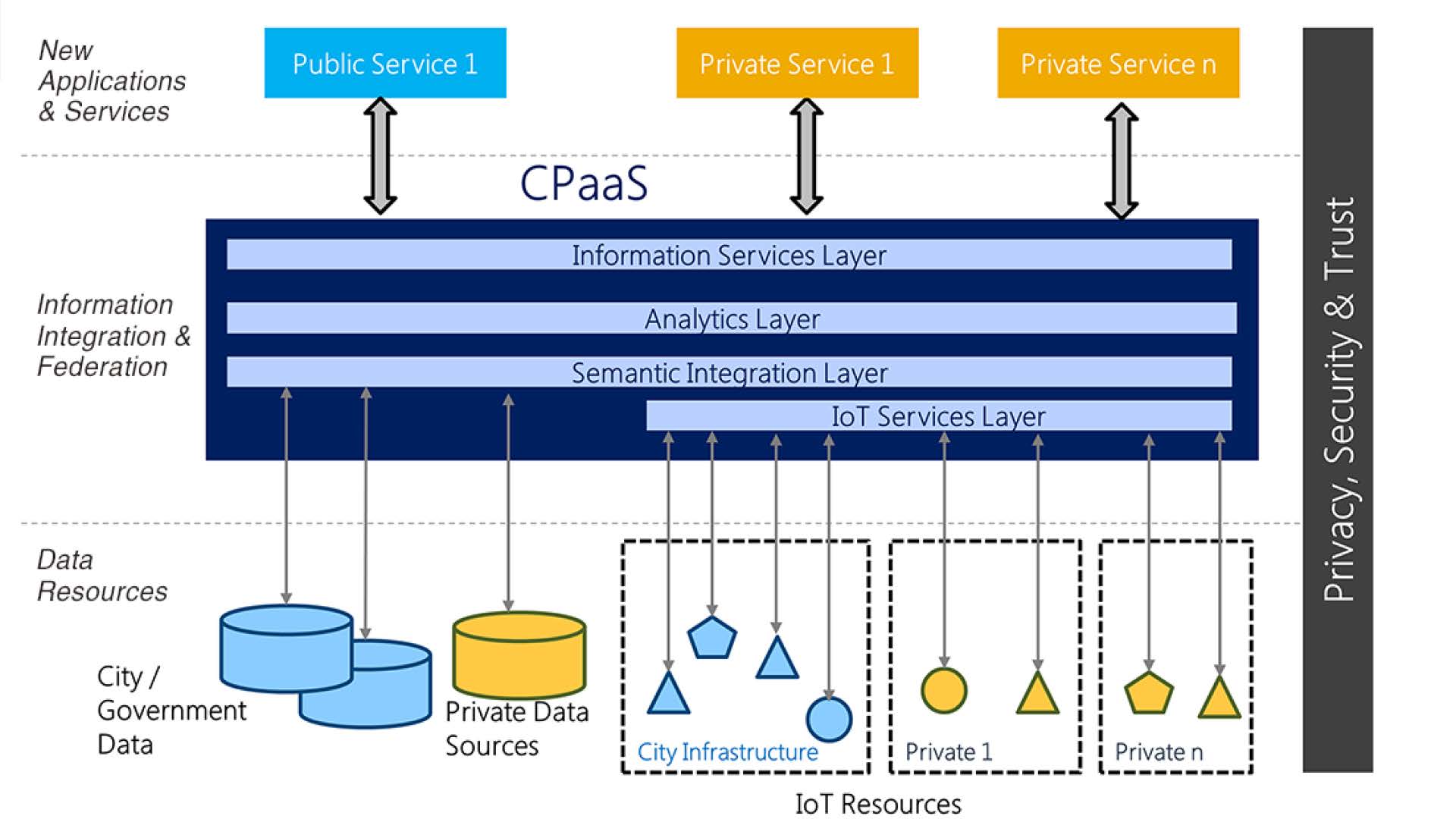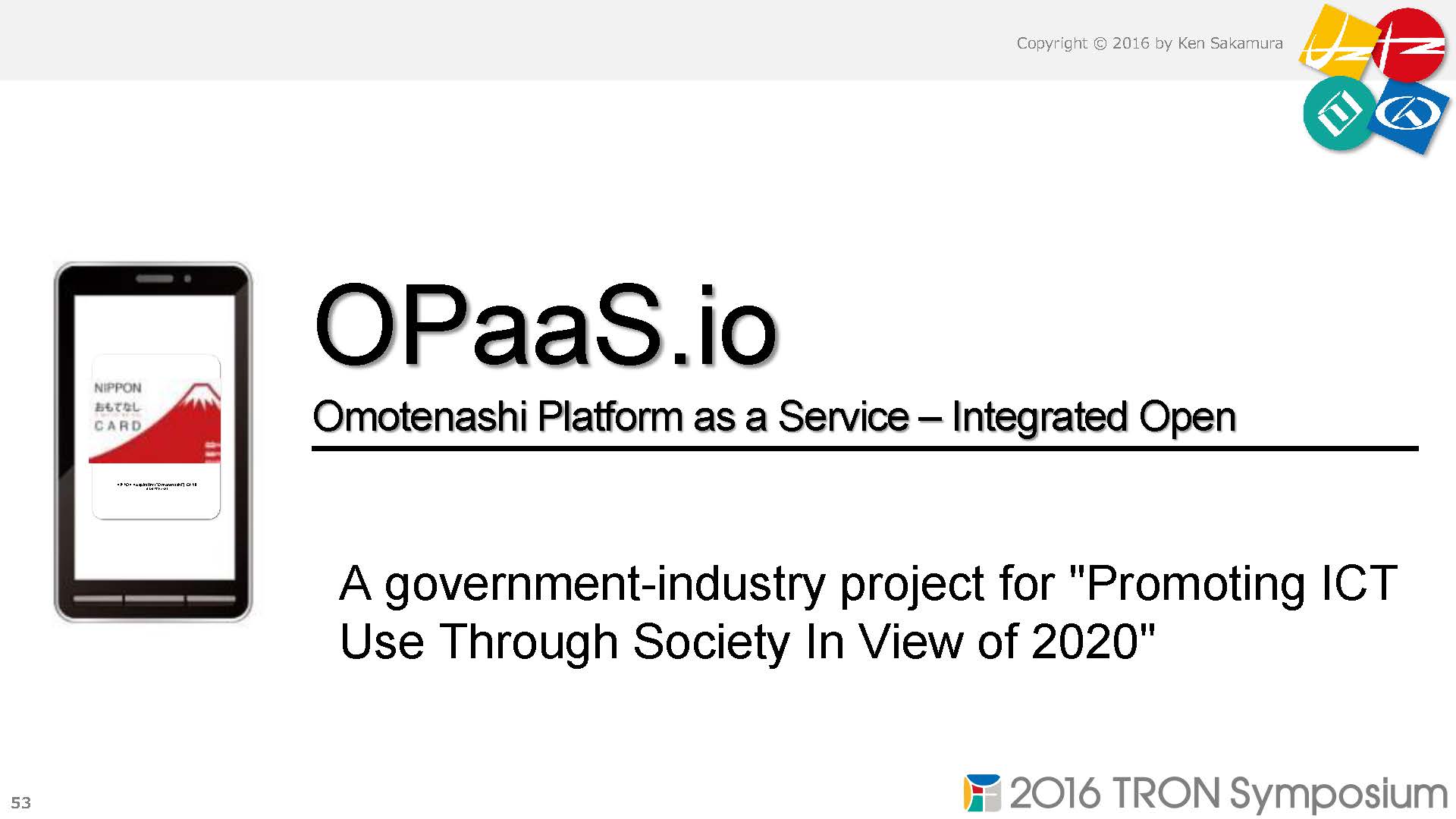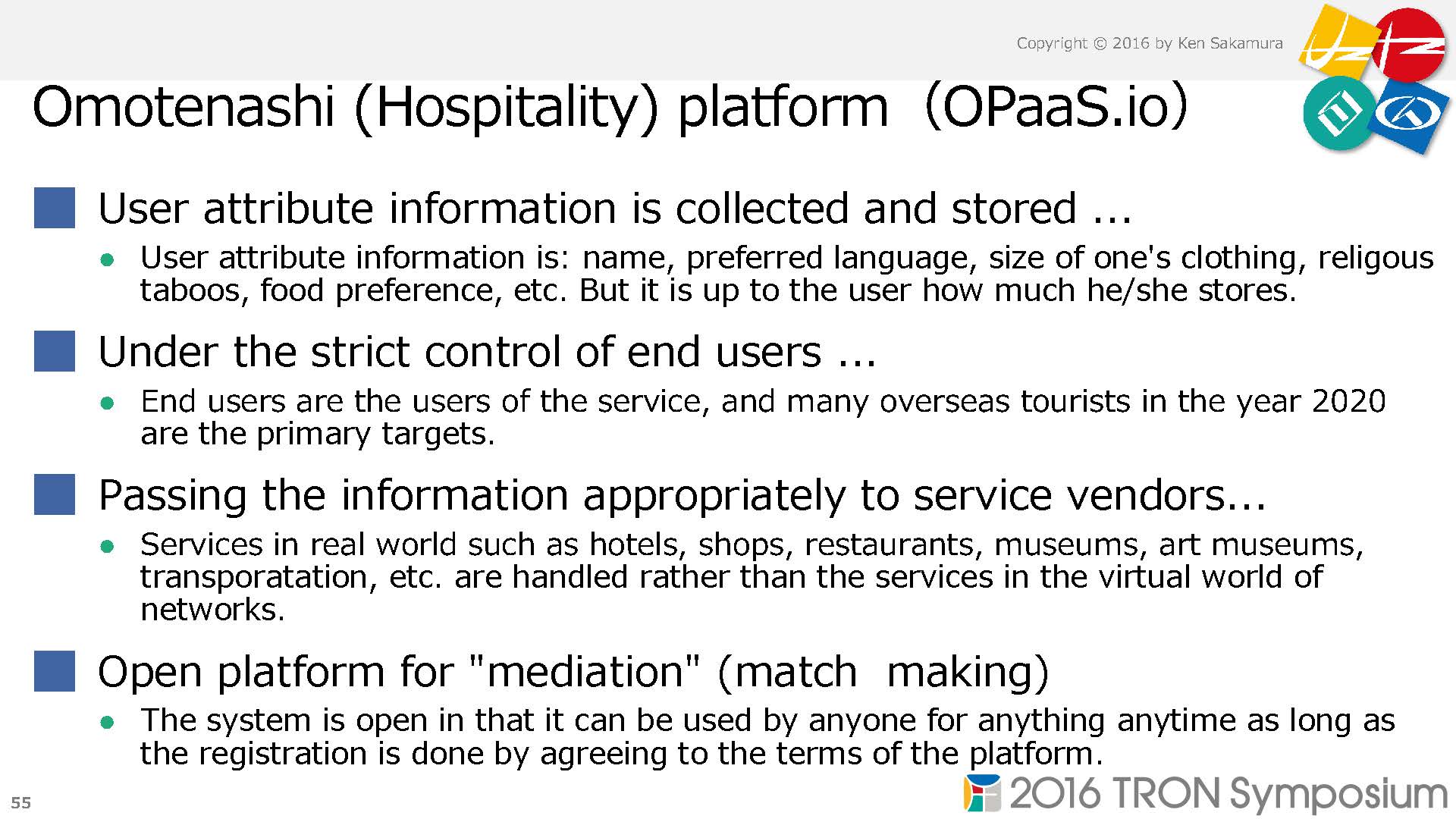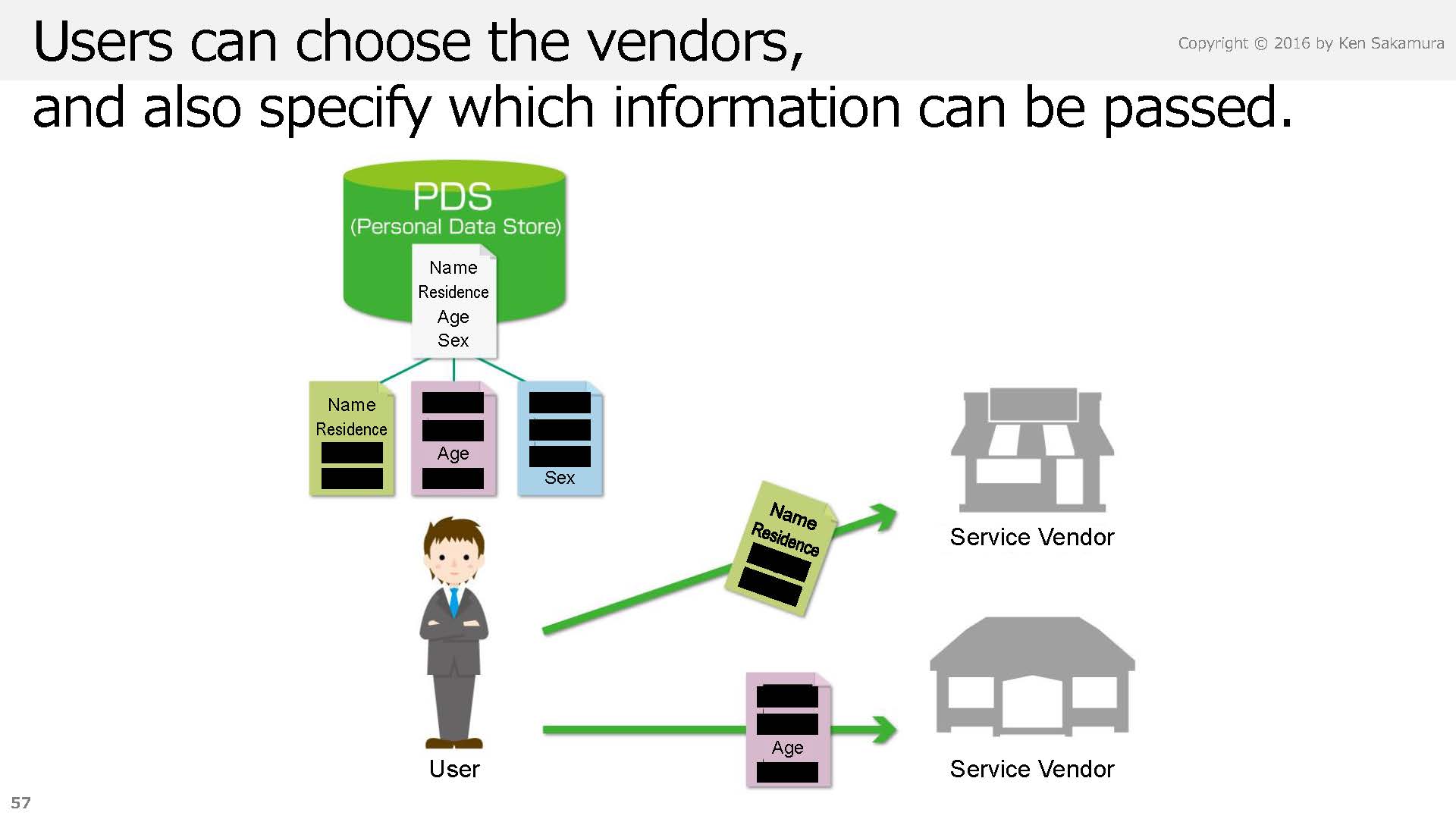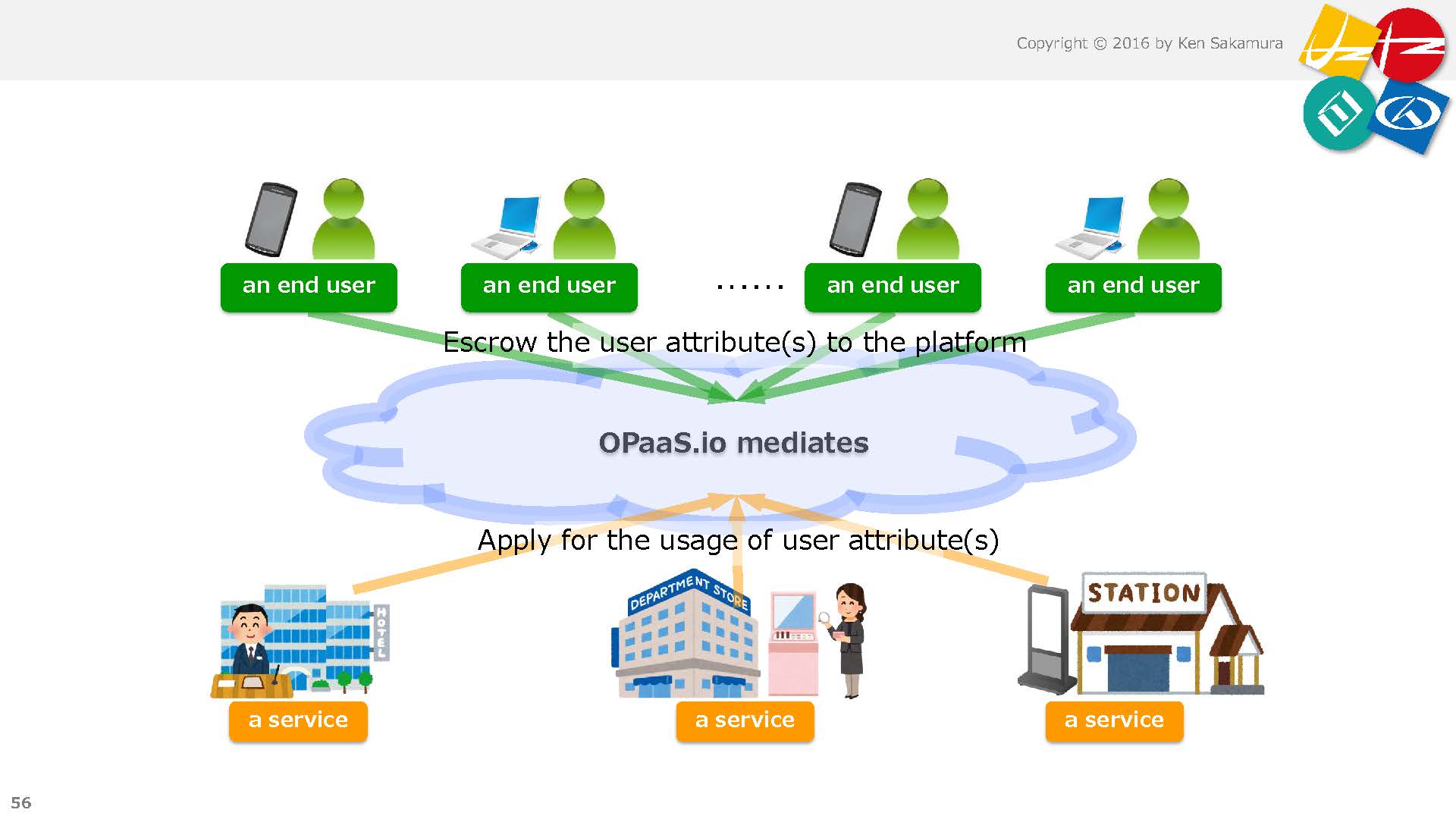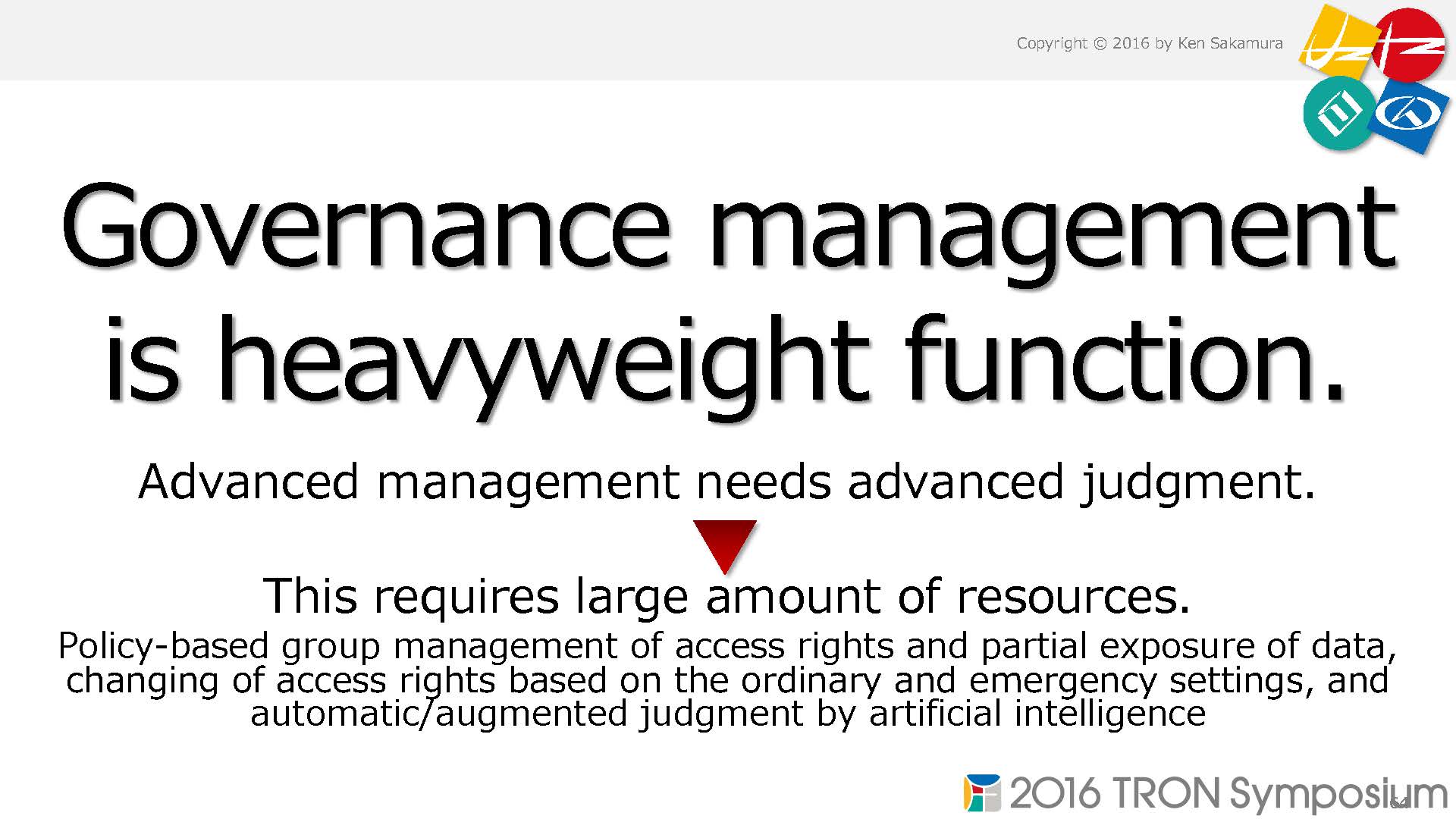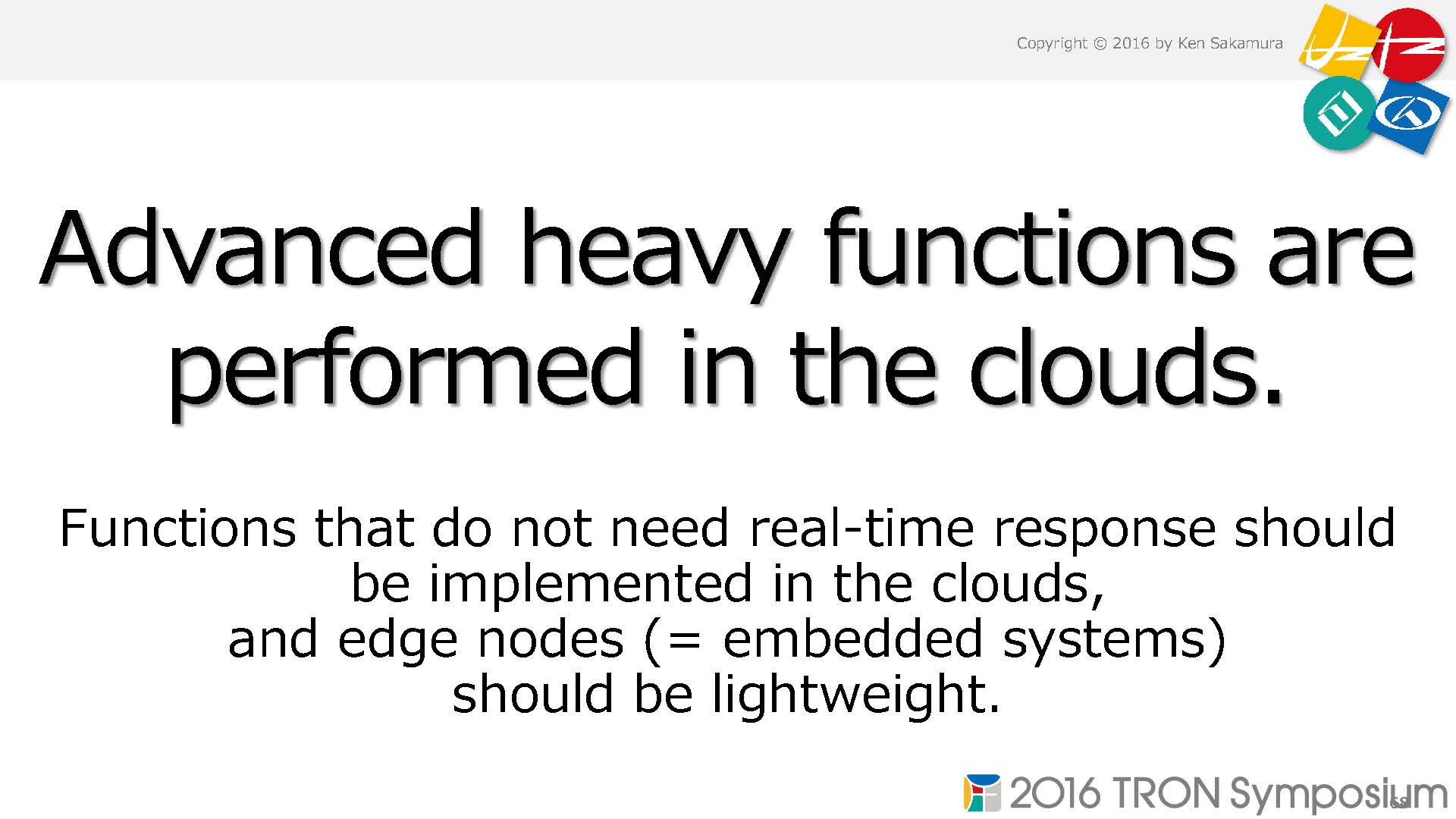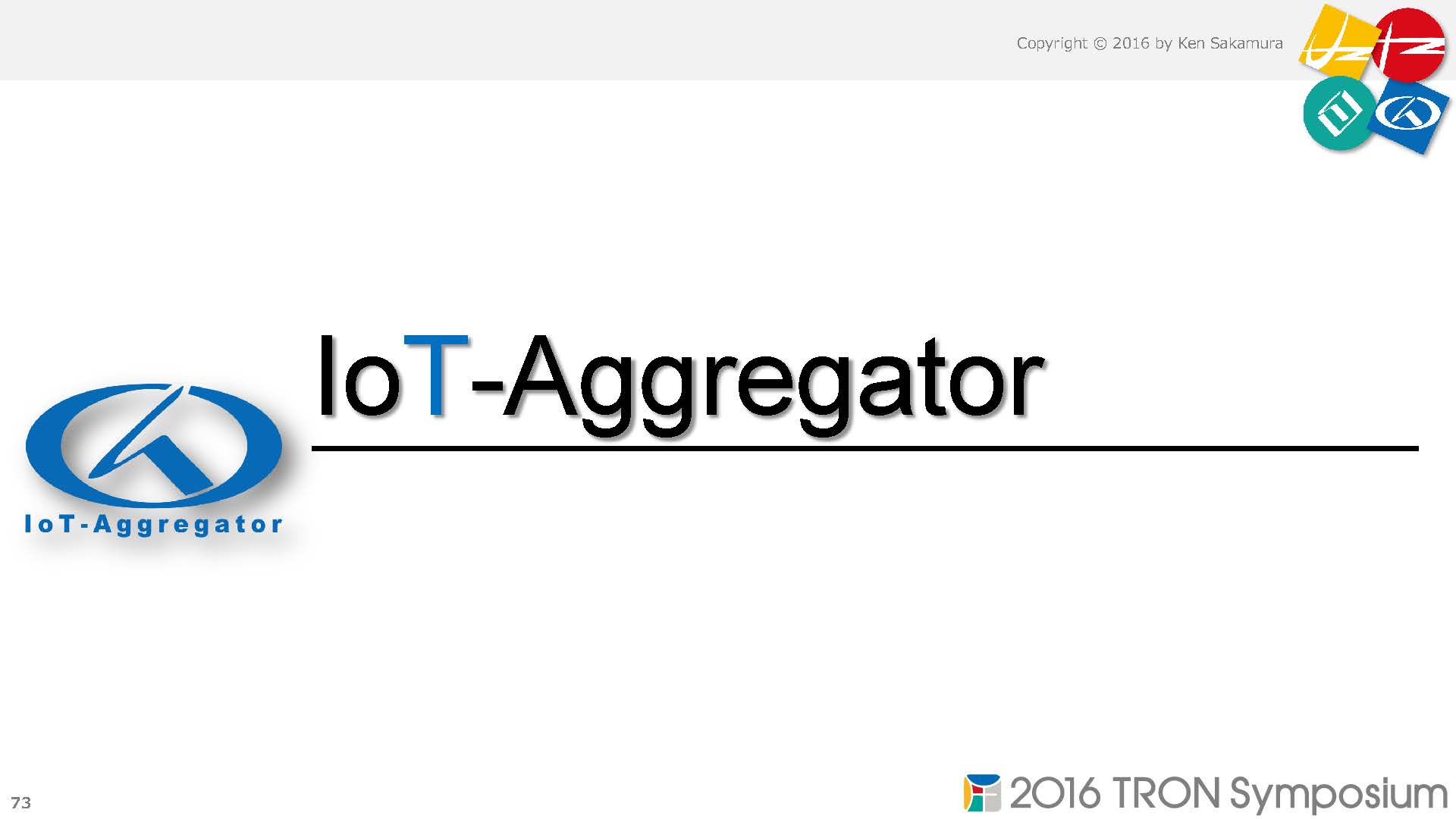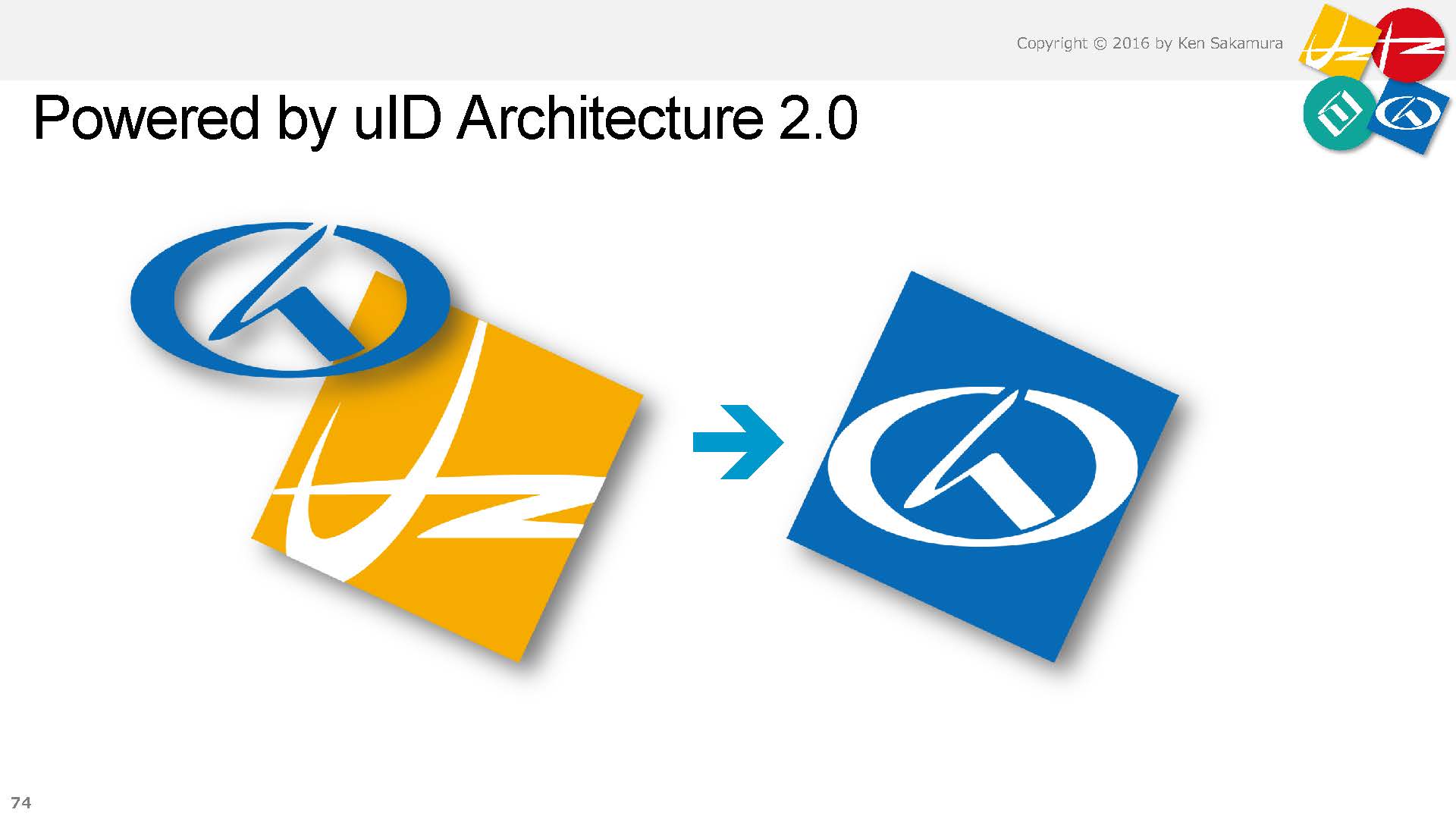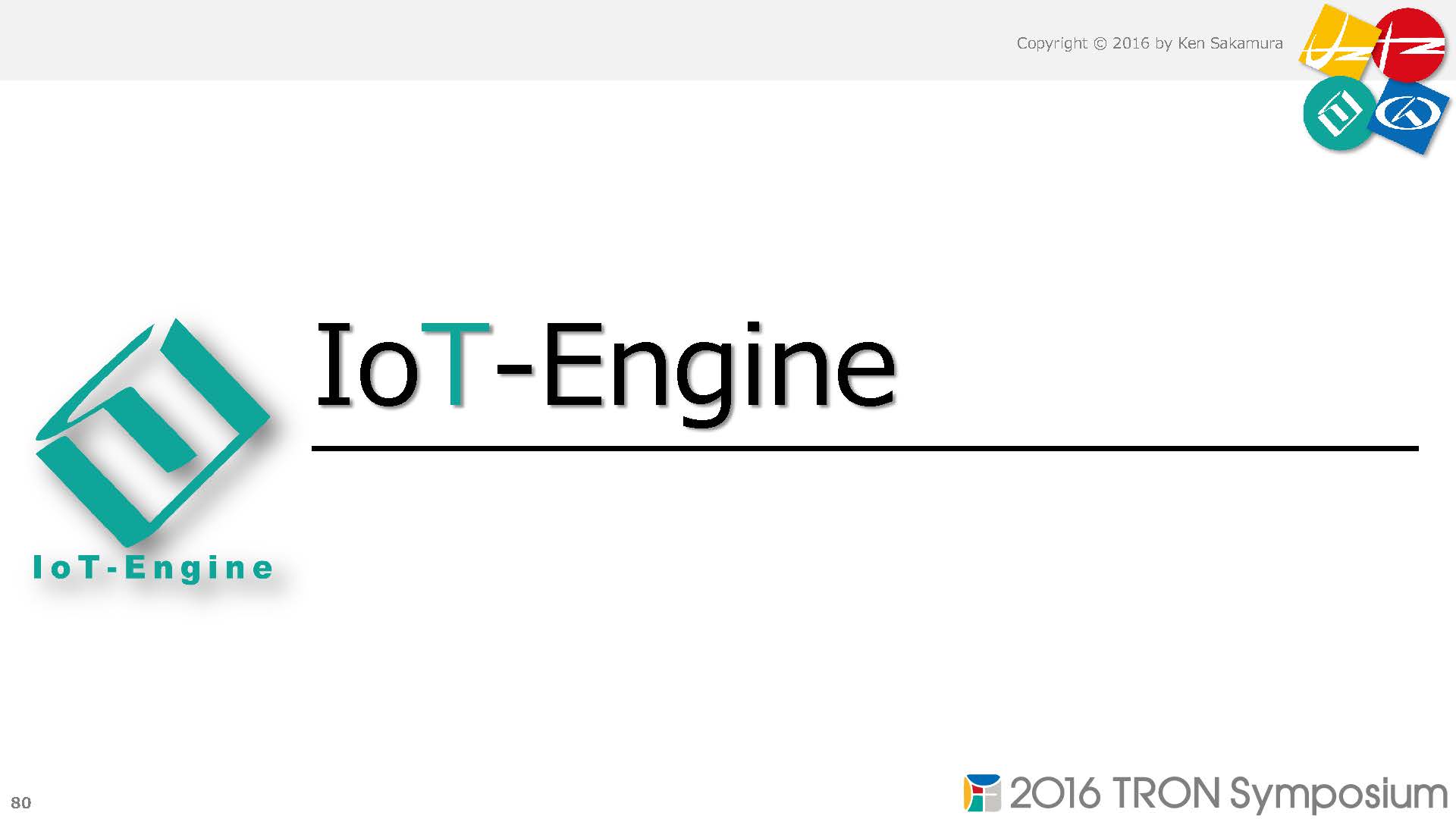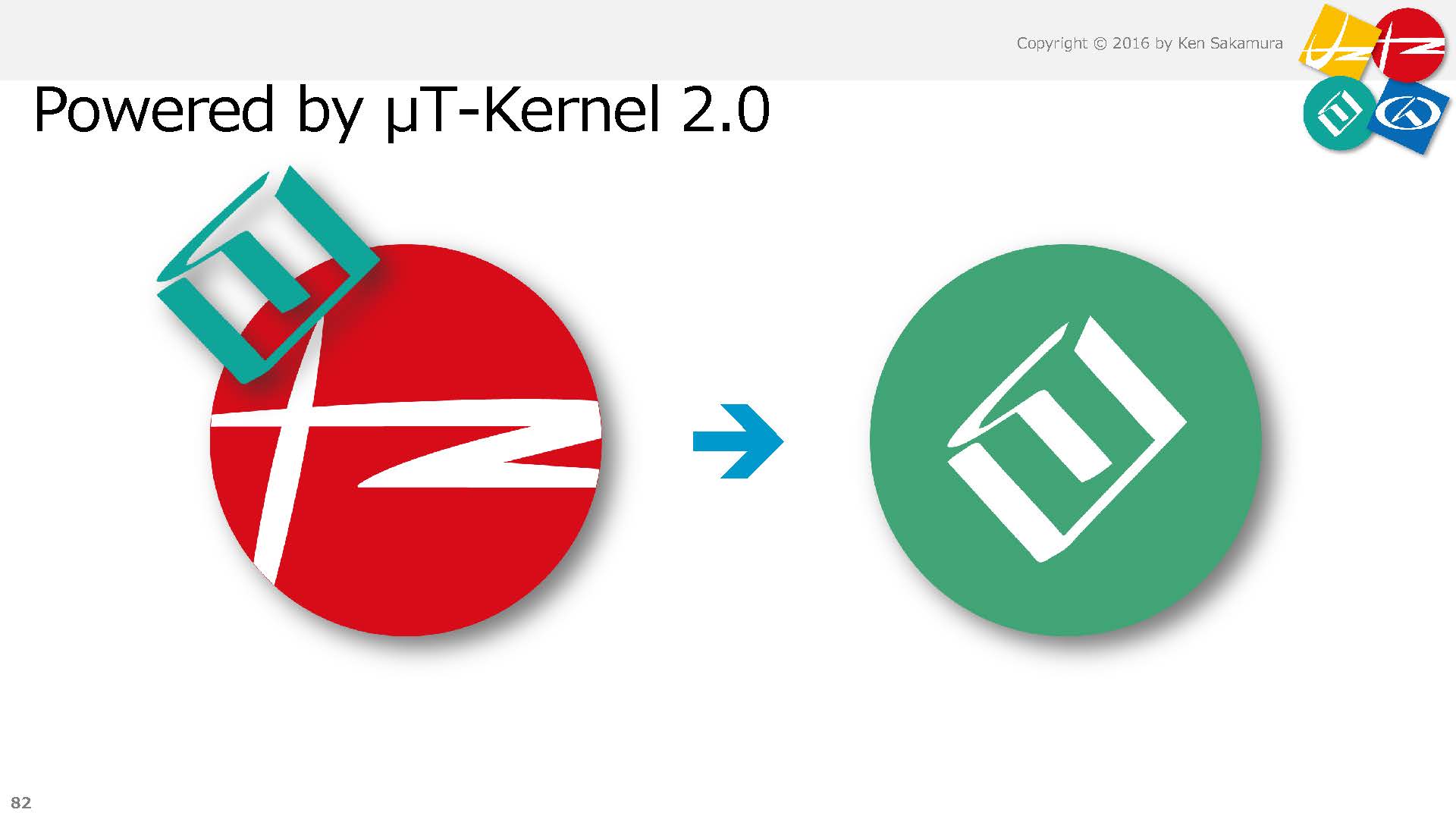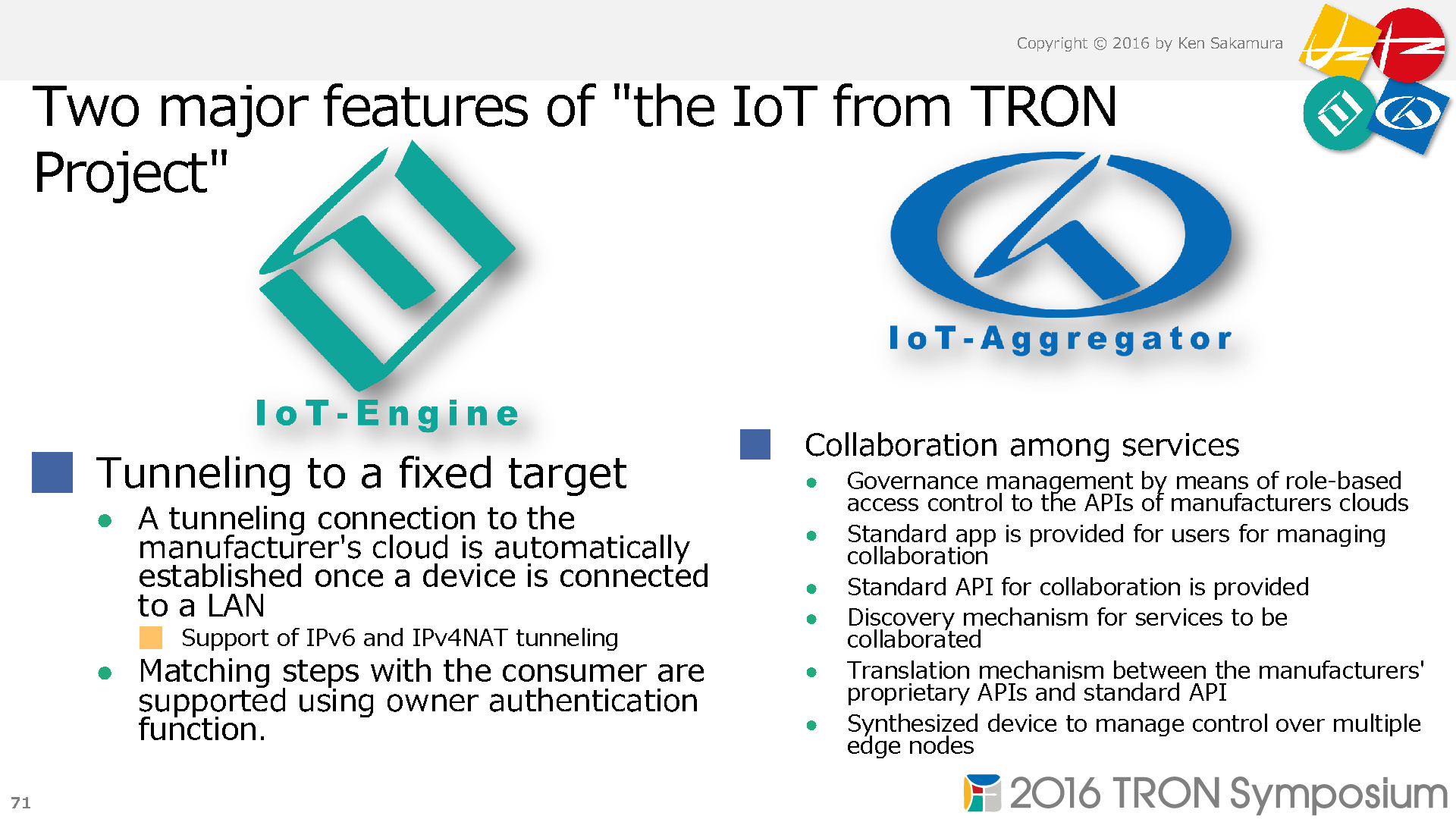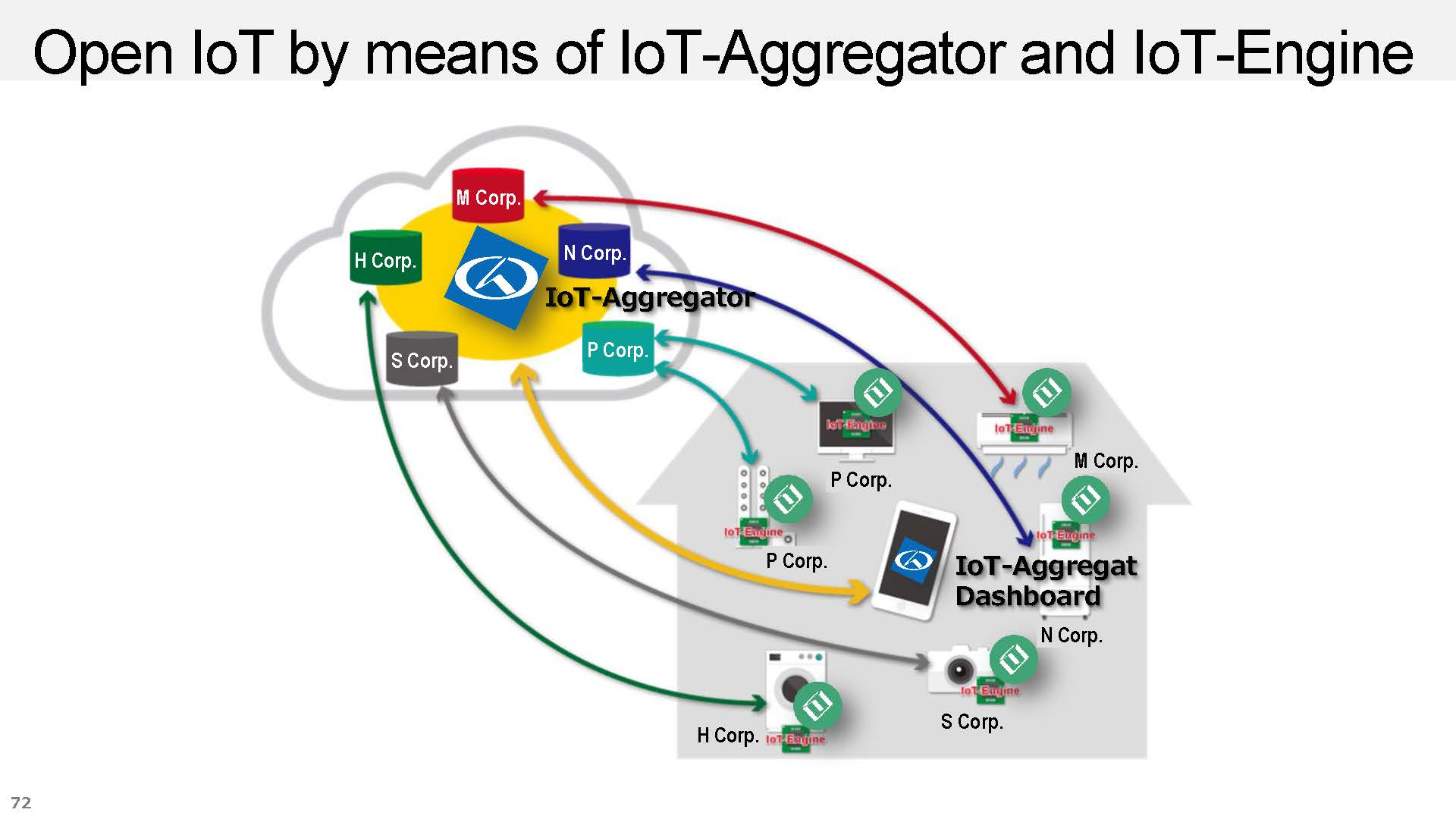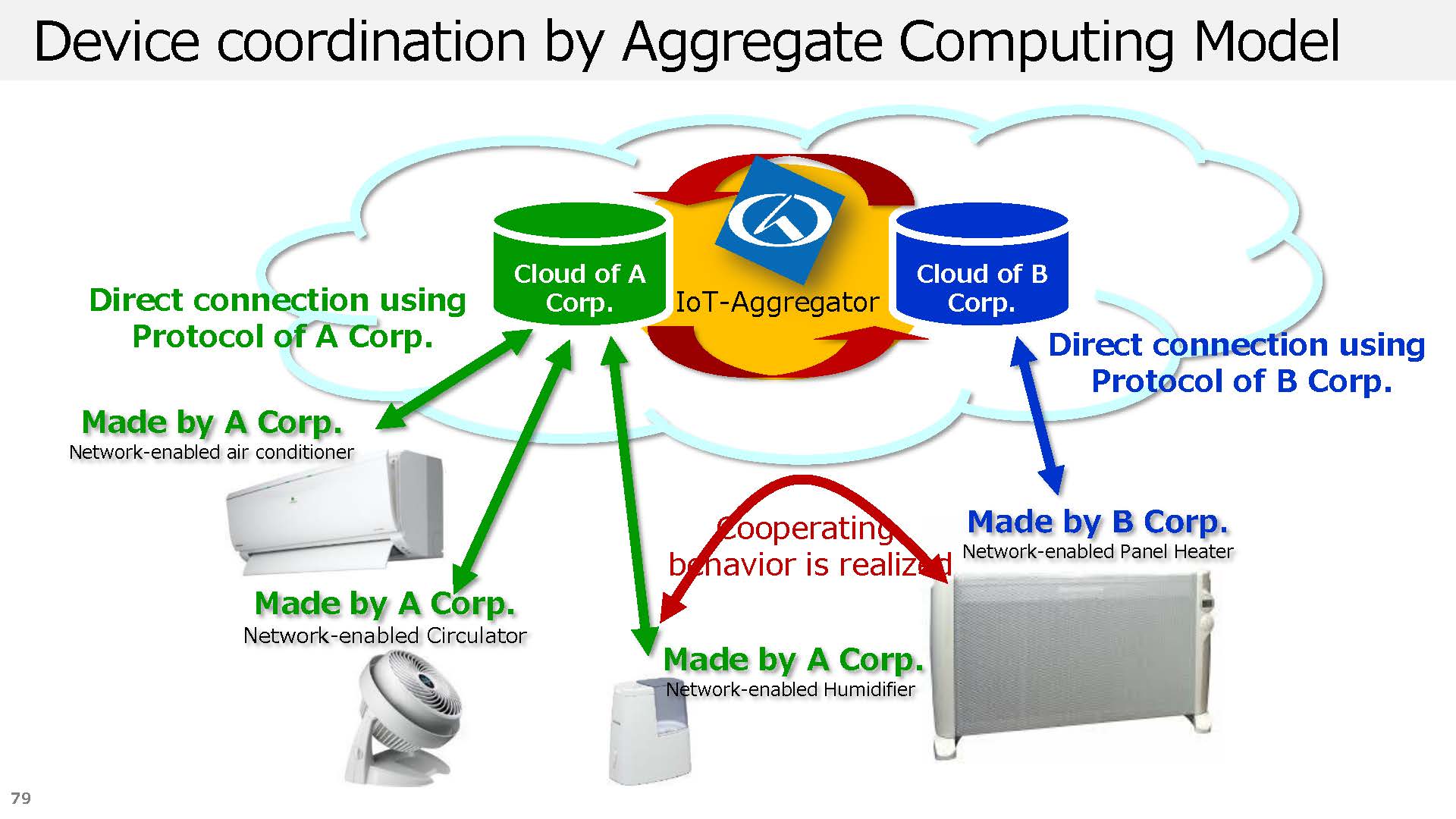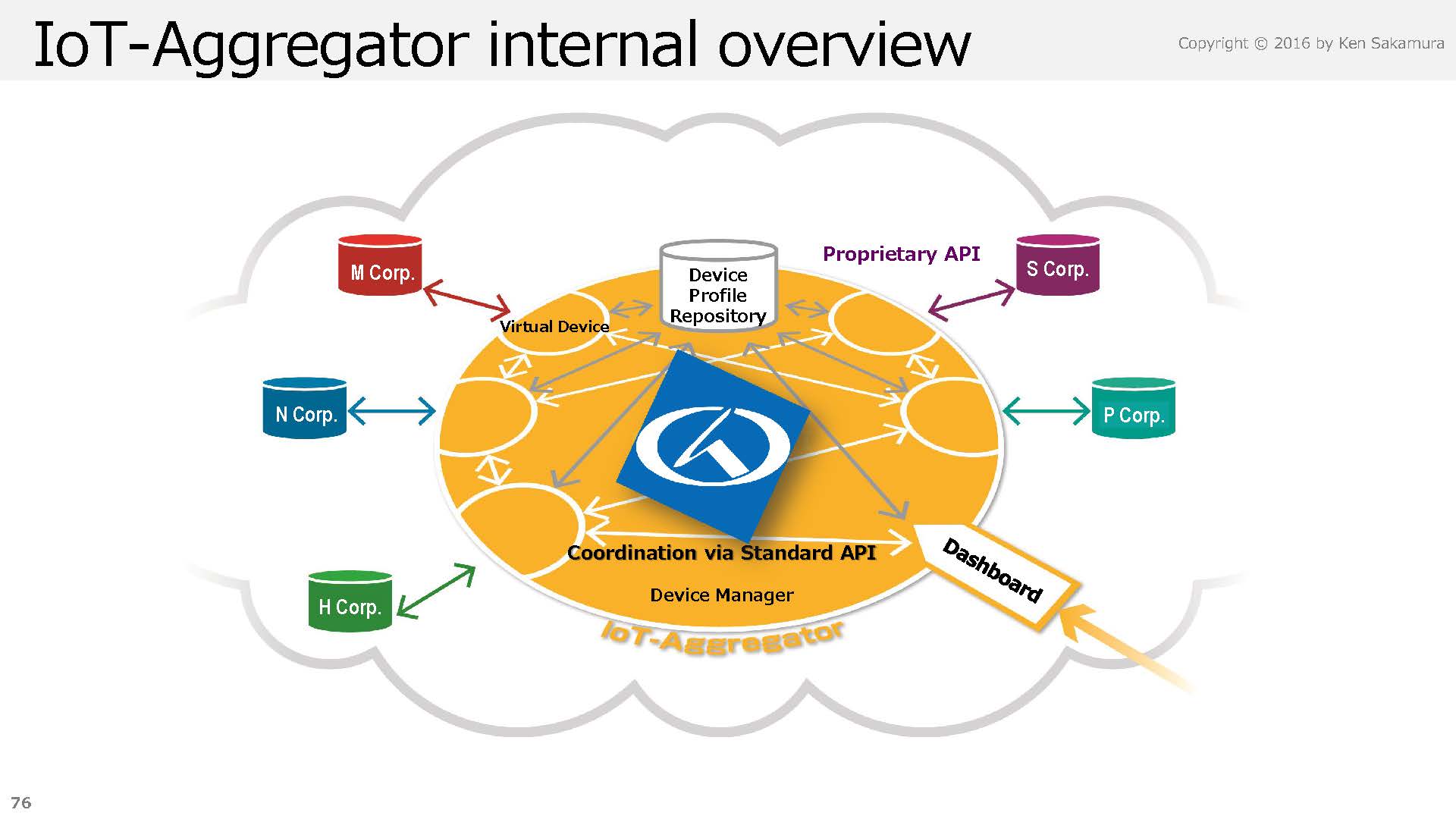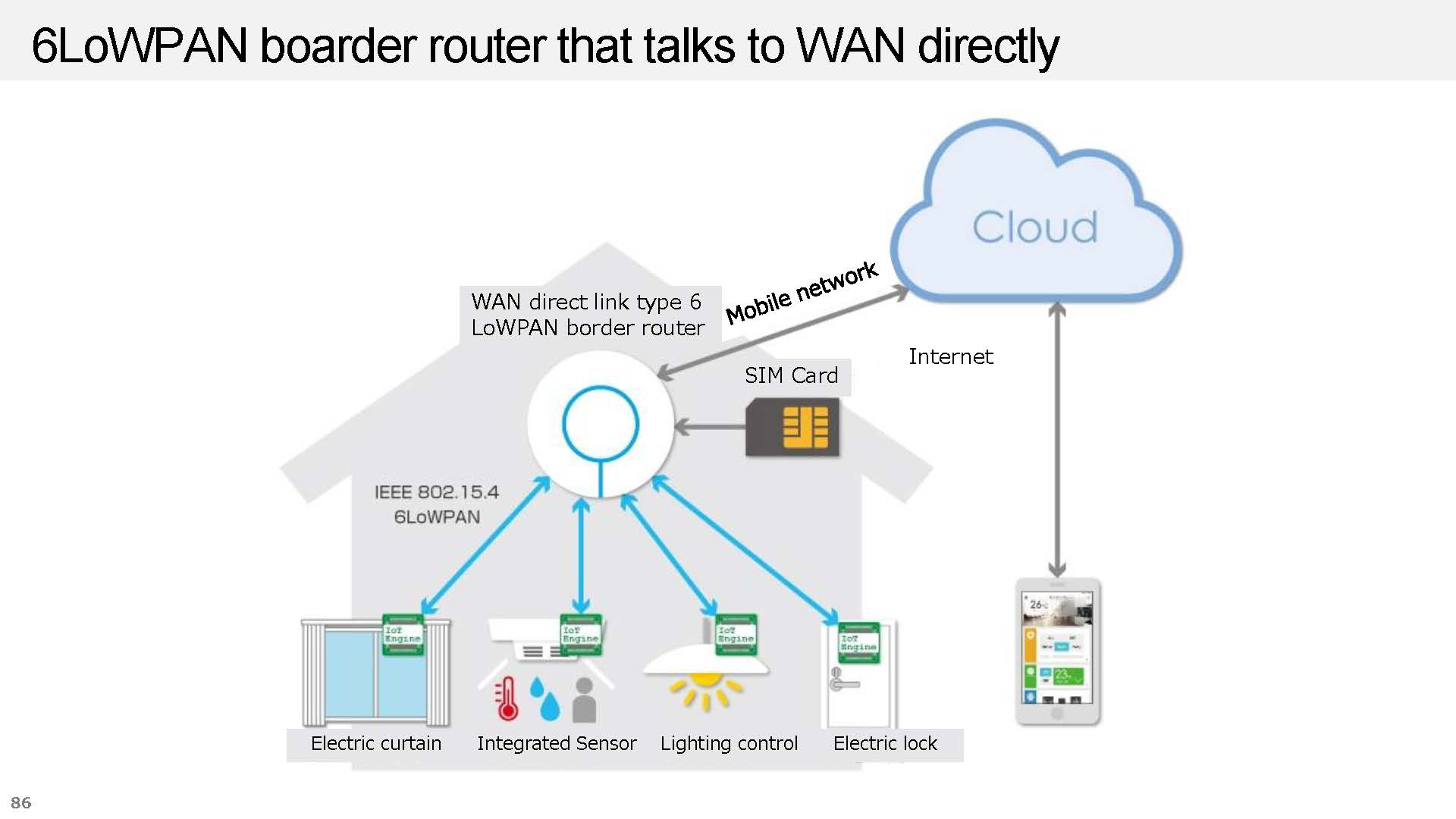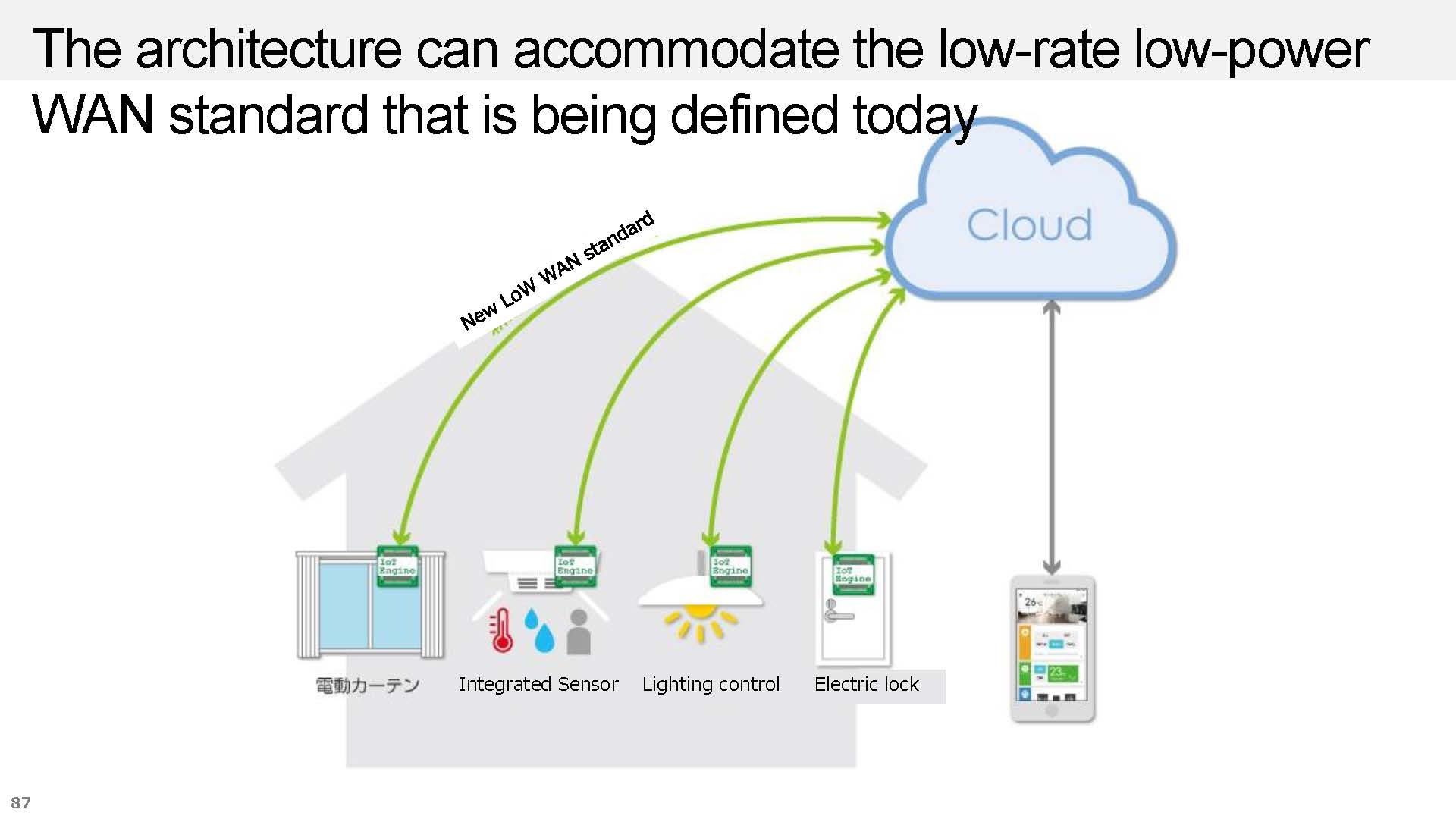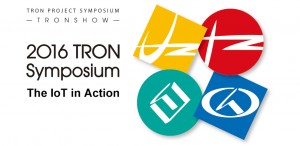
1. Building Controlled by Open API
Department of Information Networking for Innovation and Design (INIAD) in Toyo University
I will serve as the Head of the Department of Information Networking for Innovation and Design (INIAD) from April 2017. Construction of the campus is proceeding for this new department. We refer to this campus as INIAD HUB-1. We asked Mr. Kengo Kuma, who is currently working on the construction of the new national stadium, to come up with the exterior design under my overall production. I am in charge of the design of the IoT facilities, etc. We are currently making the final adjustments ahead of opening. This will be a state-of-the-art campus that uses the IoT. The facilities such as doors, lockers, elevators, lights and air conditioners will all be connected to a network with computer control and be controlled from anywhere. These will be extremely large IoT buildings.
There are many sensors, including BLE markers, in the building to identify your current location. BLE marker, one of the sensor types, generates power with solar energy. Therefore, it will not be necessary to replace batteries. The standard for BLE marker as the ucode tag has been established by TRON Forum. The underlying software at the PaaS level is available to combine the information from various sensors to identify locations indoors. Therefore, you are able to find where you are in the building and where you are heading. This means it is possible to easily make a system that guides you to your destination.
In addition, control modules have been prepared to control various devices in the buildings, such as card readers and doors that use IoT-Engine. Moreover, we have also developed an integrated sensor module. This makes it possible to freely embed sensors according to purpose to measure the temperature, humidity, wind speed and other conditions of the air. The sensors can be installed outdoors to measure the conditions of the outside air in addition to the temperature and humidity. There is a mechanism to aggregate all the information in the cloud by connecting these devices to the cloud with 6LoWPAN, a wireless communications protocol that can talk directly to the Internet with low power consumption.
Open IoT Building
I will now explain how the INIAD HUB-1 devices work. First, information obtained from outside the building by using open data is gathered in the cloud. For example, information on the weather, the delay of nearby trains or a fire in the vicinity. After this, information such as temperature, humidity and how many people there are that can be collected from sensor modules installed in the buildings and on campus is input to the cloud. The information thus collected is comprehensively analyzed to support objectives such as minimizing the energy consumption in this building or guiding you to the room you would like to visit.
To achieve this, first, all edge node devices must be created based on the concept of an open Application Program Interface (API). The API needs to be completely open. Researchers and students can read node operation information and can control nodes via an open network by using the published API.
Location Identification
In times of disasters in INIAD HUB-1 building, it is possible to evacuate people in the safest way by recognizing where they are. It is also possible to check attendance in classes and manage entry/exit by using dedicated app and personal IC cards, and to post information by using augmented reality (AR) in most locations and control facilities according to access rights.
It is very important to control facilities according to access rights. It would be a problem if anyone knows the API commands to control facilities and could turn off the lights during a class, for example. The building has an access control mechanism so that students cannot control the lighting when the class is in session.
We are also trying to use AR technology to post information that fits the location. For example, it will be possible to take a photo of a location on your smartphone and then perform image recognition to display the way to the restroom by using the above-mentioned indoor location information system with AR.
Optimization of Room Temperature and Energy
The environment can be optimized to satisfy the people in a room by automatically turning on the lighting and air conditioning when someone enters there. For example, when a lecture is given in a classroom with 30 people, there will be different opinions about whether it feels hot or cold. In this case, it is possible to set the temperature of the room to the average value of the preferred temperature of the people. The room temperature can be adjusted to suit the preference of the oldest or sick person. The policy that controls how to set optimal room temperature can be adjusted with a program. This is a study about whether air conditioning setting can be decided automatically through discussion.
In addition, we are conducting research to make elevators stop at the designated floor automatically according to the route guidance. Normally, you just press the button of the floor you would like to go to in an elevator and do not specify how you go to your destination. Accordingly, I am thinking of starting a research on whether it is possible to optimally control elevators based on the data of where you would like to go. Elevators consume a great deal of power, so there have also been studies on how to optimize energy usage which is one of the objectives of the IoT in the past. I think it is very important to reduce energy usage by thinking about it in a holistic manner.
Use in Research and Education
The open API in INIAD HUB-1 will also be used for a variety of research and educational purposes. For example, operation of automatic robot wheelchairs, control of numerous drone flights and campus security that uses deep learning. Unlike with conventional artificial intelligence, learning takes place with lots of data in deep learning rather than humans writing a control program. It is necessary to collect a large volume of data on a routine basis to understand that there is a need to issue a warning when an abnormality occurs in comparison to the ordinary state and movement of people.
There is a mechanism to collect information on the movements of people on the campus in a statistical manner, temperature changes and energy consumption. Students can learn about the programming of our environment by controlling this building using such data.
Instant Research Trial in the Field
I oversaw the construction of Daiwa Ubiquitous Computing Research Building, which may be called the prototype of INIAD HUB-1 on the Hongo Campus of the University of Tokyo in 2014. The exterior of this building was also designed by Kengo Kuma, so, I think they have similarities. I wonder if the new national stadium will also be like this (laughs). This building has an unusual exterior design similar to the scales of fish. In fact, the results of our trials here have been improved and used in INIAD HUB-1.
INIAD publishes the API in INIAD campus to students and researchers so that they can test their research immediately in the field: this will encourage the development of new user interfaces. For example, we normally use wall switches to turn on lights. However, it will be possible to use the published API to introduce new interfaces quickly. There are hundreds of cameras in INIAD for security purposes. We can use these to create a user interface which allows those who cannot press the button to use a gesture – such as raising their hands to turn on the light and lowering their hands to turn it off – or vocal commands such as “light on” or “light off.” Thus, various kinds of trials can be immediately performed in the actual environment.
We have not finished ceilings in INIAD HUB-1 so that it is possible to install new IoT devices. It also helps to reduce the construction cost, which is good for Toyo University. The cost is considerably reduced just by not having ceilings when it comes to a large building like this. In that sense, not having ceilings is partly for research, but also about making cost savings (laughs). In terms of floor space, INIAD HUB-1 is about seven times the size of Daiwa Ubiquitous Computing Research Building, about 10 times if you include the space outside. The number of items that can be controlled in this building has increased from 200 to 5,000 and a considerably large number of things have been connected. This has evolved into an intelligent building in which you can control thousands of devices.
2. From the IoT to the IoS
No Distinction between Things, People and Services
Open API coordinates any services and data from various sources in an open manner: houses, buildings, external sources, government open data, etc. I have recently been advocating the switch of the names: from the Internet of Things (IoT) to the Internet of Services (IoS) – in other words, linking all services via the Internet.
The essence of the IoT is that objects are automatically linked by the API. Furthermore, I have recently been thinking that there is no need to distinguish between objects and people. Objects and people can cooperate automatically by means of the API. For example, in the Uber car dispatching service, you give an instruction “come here” on your smartphone from your location. Of course, a human driver sees the instruction and comes to where you are. However, when you call a car to your location, it makes no big difference whether you are connecting to a human driver or an autonomous car as long as you go through the API in the end. If there is no distinction between instructions to humans and those to machines, we can create a world where all such services can be coordinated.
There is no need to distinguish between whether they are people or objects that are being connected to. This is the IoS. I am thinking of building a larger model than the IoT.
If only objects that are connected through the API, it is IoT in a narrow sense. If buildings are connected through the API, it is an open IoT building platform. If people are connected through the API, it is a matching service, for example. If organizations are connected through the API, it is the so-called API economy which is a recent trend. Open data is part of this API economy. If the organizations that are connected through the API are financial organizations, it is a service scenario called fintech (financial technology). I believe a new world, in which all such things are connected by the API, will be created.
Supporting the IoT Society through API Coordination
Let me talk more about the API economy. In light of self-driving cars, it is very important to have insurance, as well as laws such as the Road Traffic Act in the current automobile society of course. Accidents will definitely occur when a car is driven by a person. Naturally, the same goes for self-driving cars. Therefore, we must build an automobile society under the premise that accidents will occur. Of course, it will not be possible to reduce the number of accidents to zero even if only robots are walking through the streets. Nevertheless, I think it would be better to use self-driving cars, and we should harness the power of robots to support human beings.
It is very important to have laws, of course, but insurance becomes important. It has now become possible to dynamically change the insurance rate through API: setting the insurance premium higher for elderly people driving after 10 p.m., halving it if they drive during the day and making it cheaper if they use self-driving cars, for example. We can think about self-driving cars and automatic robots realistically only after the realization of a world of API economy, in which all things, people and services are connected in the cloud. It is difficult to realize the IoT society only with technical achievements such as connecting lighting or security systems to the Internet. In other words, it is important to design social systems, including insurance framework. It is hard to run the IoT society well without drawing up such social framework designs.
For a long term goal, TRON Project will focus on building a world in which all organizations, people and objects are coordinated by API under the name of the Internet of Services (IoS). The IoT is to connect objects, and I think what lies ahead of the IoT is the IoS society in which people and organizations also cooperate with the IoT.
3. Open API for the IoS
Providing Support More Easily for Physically-challenged People
It seems that many Japanese companies hesitate to publish the APIs of their products. A variety of devices such as televisions and air conditioners have been connected to the Internet recently and can be turned on and off from outside. Now, it is necessary to have a concept of publishing the API such as the commands to turn on and off the devices to connect them beyond the boundaries of manufacturers. The world has started to become aware of this need and it is only relatively recently that it has become a trend to publish API. In any case, if the API is closed, devices cannot be connected and devices can be controlled only by using the smartphone apps of their own manufacturers.
Open API allows volunteers to develop human interfaces for physically-challenged. For example, let’s think about who makes systems that allow physically-challenged to control home appliances only by using their voices or gestures. The market for physically-challenged people is not that large, so it is difficult for manufacturers to commercialize such systems.
However, with open API, many volunteers can help build a system to, say change TV channels or turn on air conditioners by using a voice or gesture command. The cost of development is spread over many volunteers, and distribution cost is small now, so it is possible to create apps designed only for 100 users.
Innovations with Open API
I keep saying “Open API is important” because it is necessary for many people to participate. You had better stop thinking about developing the IoT technology inside a manufacturer and making everything on your own without publishing the technology when you plan business development of IoT technologies. I think you can succeed only by pursuing open approach such as publishing all you have and letting others create programs.
The IoT connects the virtual world and reality. This expands the possibilities of challenges and brings about many innovations. That is why I say I think API should be open and the world of objects should also be coordinated and made programmable in an open manner like the world of the Internet.
RICOH THETA 360-Degree Camera with Open API
I talked to RICOH about the same topic at various places and met many people who agree with my opinion. RICOH said “We agree with what you have been saying and would like to make an IoT camera with open API.” Accordingly, the RICOH THETA × IoT Developers Contest was held to encourage many people to join and create apps to control this camera by publishing its API.
The total amount of the contest prizes was five million yen. The prize money is important. This is what is called the X prize method in the United States and elsewhere. This is different to the method of asking someone to develop something for you when you would like to have it developed and then giving the development funding to the candidate(s) with the best proposal. In the X prize method, money is only given when something has been made already. You then give money as a prize to a party who made the best product. This is a method to encourage development.
The RICOH THETA is a quirky camera; it only comes with a lens (laughs). Moreover, it is a 360-degree camera that can take images and video in 360 degrees. This camera can be controlled completely from the Internet. It has one shutter button. However, you do not need to use it as you can give instructions to control the shutter of this camera from the Internet. The API for this camera has been published so you can make an app to control the shutter yourself. The API to change the aperture or shutter speed has been published because Ricoh agreed with what I have been saying.
In the contest in which I served as the chief judge, we received some interesting submissions. The entry of Shotoku Tamago, which won the first prize, is a teleconference system that uses the RICOH THETA. This is software that crops out just the face of the person talking and displays it on the screen in real time. This is something that is not so easy to explain in words (laughs). However, it is a system with a high degree of perfection.
In addition, there was a system to generate AR images in real time using 360-degree video with the image-based lighting (IBL) method. That was an entry from a contestant in the United Kingdom. IBL is a lighting method that uses images as light sources. The contestant said it was relatively straightforward to create the entry as a result of using the open API. Thus, there were many entries that excited the judges.
Open Data: A Type of Open API
Next, I would like to talk about open data. Open data is extremely important for the IoT. For example, even if it becomes possible to control lighting, it is desirable to have information on the room conditions when you want to achieve even better control. It becomes even easier to control objects when you know where the doors are, how the chairs are laid out, the size of the ceiling in the room, etc., for example. Making judgements derived from such conditions and controlling objects is very important for the IoT.
As I just mentioned, the open data is a type of open API. Data that can be retrieved via a network by using API is defined as open data.
Importance of AI Technology
It becomes very difficult for humans to perform optimal control if all kinds of data such as large amount of sensor information and open data enter the cloud. Accordingly, as I have been saying, analysis by artificial intelligence (AI) will become very important. To be precise, I am referring to Deep Neural Network (DNN). We are not a group of AI researchers. However, we have a strong interest in using DNN to control IoT devices from the standpoint of AI technology users. I think we will be able to report on the use of DNN AI in 2017.
Global Movement toward Open Data
The United States was the first in the world to start open data. President Obama announced a memorandum on transparency and open governance on the day he was inaugurated as president. I believe it was the United States that first stated government data should be proactively published to strengthen democracy and increase efficiency and effectiveness in government. The movement to publish data at the state level first began in the United States before spreading to the United Kingdom and then other European countries. DATA.GOV website of the United States had 47 entries in 2009, and nearly 160,000 entries of government data were made open by April 2016.
What is very important here is that open data needs to be published in a way that can be read by computers. For example, PDFs are not open data. This is because computers cannot directly handle image data even if such data is published. Open data can be used by retrieving it via API when it is necessary. An increasing number of government data are published in this way all over the world now.
The Japanese government has also started proactively to publish government data since agreeing to the Open Data Charter at the G8 meeting in 2013. Data that anyone at large can access easily, read with a computer and can use for free has started to be available in large quantities in Japan.
Open Data at the London Olympics
The city of London transformed basic traffic data, statistical data, live data and other Olympic data as open data for the London Olympic and Paralympic Games in 2012. The open data has become a very important legacy even after the games were over, and created many traffic apps and services. It is said that the economic effects of this alone are worth between 2.5 billion yen and 9.8 billion yen.
Many people acknowledge that open data has been useful to improve the functions of the city. The London Games have triggered a global trend to make open data available to the public. London has also published dynamic live operation data. For example, you can check the current location of the bus for which you have been waiting for a long time at a bus stop, and see whether it is still far away or it will soon arrive.
From London to Rio
Open data were used proactively to enliven the Rio Olympic and Paralympic Games held this summer. A large amount of various types of information such as information on history, administration, transportation, tourism and urban planning was published using a site called data.rio. As in London, a transportation app contest was held, and many smartphone apps which allowed tourists gathering in Rio from all over the world to go to their destinations without trouble using the transportation network were created.
Moreover, app developers and those involved in the IT business around the world have been entering into the market in places where data has become open. The development proceeds worldwide instead of regionally.
Although it was said that the people going to the Rio Olympics had a difficult time, a variety of information services were provided. However, such services could not be utilized fully unless the infrastructure of the Internet was in place. In that sense, a variety of transportation-related services were developed by using the world’s most advanced technologies, but the infrastructure was not sufficient. The development of an Internet environment in where the access is available anywhere is another topic, but is very important.
Next: The Tokyo Olympics
The Tokyo Olympic and Paralympic Games will be held in 2020. The open data movement has been led by the government also in Japan. Recently, such momentum has also been picking up gradually in the private sector. The activities of the Association for Open Data of Public Transportation, which I established in September 2015, have become livelier in 2016, for example.
The difference between Japan and other countries is that many Japanese public transportation services are run by private companies. In other countries, including the United Kingdom and Brazil, public transportation services are run by the local and national governments. For example, the subway trains and buses in London are run by the city. However, in Tokyo, the metropolitan government runs Toei Subway, but the other major transportation services are in the hands of private companies. Even JR (Japan Railway Company) is not a public entity anymore but a private company. The overall public transportation network consists of many private companies instead of a single government-run entity.
When run by the government, it is possible for any entity to open up data if the organization or its head says to do so. However, the government cannot order the private companies to do so. The only way to promote open data is to raise the awareness within each company. That’s why I set up the non-profit “Association for Open Data of Public Transportation” to conduct joint research on how and what data should be made open. Operators of trains, buses and airplanes are currently promoting open data approach by making available their data such as service information and facility information and storing the data collectively in Public Transportation Open Data Center.
Most of the public transportation operators running in Tokyo now participate in the association after we worked hard to disseminate my idea. I believe we will see new services that use this open data before the 2020 Tokyo Olympics by coordinating transportation operators successfully.
Making available the operation status of Tokyo Metro
It is important that everyone acts in concert, but there are some companies which volunteer to take the lead. I speak about this at each year’s TRON Symposium. Tokyo Metro has been highly aware of open data approach, and made available its data on the metro in advance of other companies. It has been participating in these activities since I said that open data was very important about two years ago, and has held a contest with prizes. During the contest period of three months, there were about 2,200 entries and nearly 300 apps were submitted from all over the world.
The “Moshimo Alarm” app is an alarm clock that uses a smartphone. Assuming that you usually catch the metro at 7:30 in the morning to make it to the office, this app will wake you up earlier than the set time if the subway you usually take is running late.
Tokyo Metro has made available a variety of data sources. An app that made a 3D animation of the subway you are currently riding moving in underground tunnel when the subway leaves from Kasumigaseki Station was created. After the data on the depth of the metro tunnels below ground level was released, apps such as these have been published one after another.
Making logistics-related data available to the public
Frameworx, a logistics company said that they would publish logistics-related data to see what could be done, and held the Frameworx Logistics Open Data Contest in the summer of 2016.
As a logistics company, it released the warehouse blueprints, layout of shelves in its warehouses and vital data of workers in the warehouses. The vital data consists of how much energy workers consume and what their pulse rates are. Furthermore, there was also data on how workers carry packages: when workers carry packages from which shelves, how long that takes, and the route they take.
In addition, Frameworx released data from the digital tachometers on its delivery trucks as it is closely related to transportation and delivery. The data allows you to understand when the accelerator/brake was pressed and how the steering wheel was turned. By visualizing the data, you can see the locations where the brake was suddenly pressed in a truck with a simple program. This is a near-miss and we can learn the locations where accidents are likely to occur.
Moreover, it is possible to investigate efficient delivery strategies by using the data on when and which roads are busy. We can grasp the conditions of the road surfaces and improve lane design and signal control.
The “Experienced Drivers! Please Tell Me about the Secret Rest Stops!” won first prize in this contest. It is often difficult to find rest stops when you drive a large track for a long distance unless you are an experienced driver. This is because there are few parking spaces for eight-ton trucks unlike for ordinary passenger cars. This is an app in which experienced drivers tell new drivers about which roads to use and where they can take a rest. This app helps solve a shortfall in truck drivers which has been pointed out in the industry.
Thus, there are great expectations to improve the conditions in logistics industry by making good use of open data related to logistics.
4. TRON’s Open Platform
It is essential to build proper platforms to popularize the open IoT and open API that I have talked about today. TRON Project has started to build platforms in collaboration with many partners.
“CPaaS.io” to Solve Urban Problems
One of these is City Platform as a Service: Integrated Open (CPaaS.io). This is an EU-Japan collaborative project. This is an initiative to make an open platform that collects sensor data gathered from open data and IoT devices to solve urban problems. We aim to share the platform to solve the various problems cities face. Of course, software development is necessary for this, and the purpose of this project is to build a platform that makes such development easier.
This project attempts to solve social problems using various data gathered in cities by making full use of edge computing, deep learning and other research results. It is expected that this will be applied to tourism, healthcare in addition to transportation.
Thus, CPaaS.io, a 30-month project to build a new platform has started in 2016.
Many partners from Japan are also participating in it. Cities such as Sapporo and Yokosuka have joined it to participate in the test bed. The experiment will also be conducted in Spain, Germany, Switzerland and the Netherlands in Europe. The concept of the project is to mutually use a common platform to solve the problems shared by cities in Europe and Japan.
“OPaaS.io” for Omotenashi
OPaaS.io is another platform. The “O” stands for omotenashi (hospitality). Therefore, the OPaaS.io is the Omotenashi Platform as a Service: Integrated Open. However, this is not just about replacing the “C” of CPaaS.io with an “O.” (laughs)
This is a Japanese government-industry joint project aiming to promote ICT in the society as a whole toward 2020. The project is organized by the Ministry of Internal Affairs and Communications to make a platform for omotenashi. The Tokyo Organizing Committee of the Olympic and Paralympic Games, the Japan Tourism Agency, IT vendors, and service vendors such as retail, tourism, travel, etc. participate in it. This project aims to build a common platform to produce services that use technologies such as the IoT and big data, so that foreign tourists can enjoy their stay in Japan.
Omotenashi quality varies with to what extent we know the personal information of our customers. Conversely, customers cannot receive omotenashi unless they give out their personal information to a certain extent. For example, if a tourist visiting from France sees information in French on a digital signage by registering their preferred language, he/she would expect to see information again in French automatically on other digital signages.
In that case, the tourist needs to provide the service with the personal information that he/she prefers French to the system to a certain extent. Some services may require your name and address. In any case, a platform needs to be secure if it collects personal information. It would be better if this is created in cooperation between the government and the private sector. Accordingly, this is a project to draft proper security policies and usage rules and then to build a platform to handle personal information so that service providers can use it.
From CRM to VRM
Our basic concept for the handling of personal information is VRM and not Customer Relationship Management (CRM). VRM stands for Vendor Relationship Management, and means that the users themselves know where their personal information is being handed over. Most Internet services today adopt CRM. This is the concept in which service providers ask their customers to provide their personal information, gather all such information and then make use of it. However, this has caused various troubles. There is a risk that personal information may be leaked or it may be offered to unauthorized companies before you are aware of it.
Consequently, OPaaS.io mediates instead of collecting personal information. For example, if a service provider wants to know what language its customers speak, OPaaS.io will inform the service provider with the information of the languages its customers speak in place of them. For example, it would inform the service provider that this person prefers French.
An ID number is assigned to a user of this service. When this ID number is sent to the OPaaS.io servers, the service provider will be informed of what language the person with that ID can speak.
The mechanism with which users can manage vendors and select which personal information to be provided to them is called Personal Data Store (PDS). In other words, OPaaS.io is a project to build a PDS platform that can be used without worry.
Feasibility Study Experiments Have Started
We are currently performing many feasibility study experiments to provide our services in full swing toward 2020. Today, if a foreign visitor staying in a hotel wishes to go to a delicious sushi restaurant because he/she has come all the way to Japan and asks for a recommendation, the concierge will search for restaurants and ask the guest, “How about this one?” This is a real situation that is quite likely to occur. If the visitor decides to go to that restaurant, the concierge will give a printout to the visitor, saying “If you give this piece of paper to the taxi driver, you will be taken to the restaurant.” The taxi driver will look at this paper and then take the visitor to that sushi restaurant after putting the data in car navigation system. This is how it is done today.
However, there are a lot of things they can simplify here. If there is information about the desire of the visitor to eat sushi on his/her smartphone, the information of the reserved sushi restaurant will be recorded in the system. Then, in the taxi, the location of that restaurant will be automatically set to the car navigation system. This is one of usage examples which OPaaS.io aims to achieve.
In addition, in case that visitors wish to go to the stadium where the Olympic Games are held, they will be able to find out which means of transportation to take by presenting their tickets at a digital signage near the station. They will also be able to find which way to walk when they get off at a nearby station. The service also can suggest that the visitors would arrive quicker by walking rather than using a taxi by judging the road congestion in a dynamic manner.
5. Technology Supporting the IoT
Aggregate Computing Model
I have been advocating Aggregate Computing Model as a model to implement the projects I have described today.
Governance management is important for the open IoT and it is necessary to have a framework of access control that can reflect governance. Nevertheless, governance management is a weighty function.
Embedded computer systems are used in many objects. So the computers need to operate with as little energy as possible. If the performance of chips in IoT devices is enhanced, more power will be consumed and lead to a severe burden on the environment. Therefore, embedded computers used in devices must be more compact and save power. This means that heavy workloads such as governance management should be moved to the cloud.
Linux, POSIX, iOS and Android have too much overhead for an embedded OS running in objects. I have been insisting for a long time that we should stop putting such OSs into edge nodes and equip them with lightweight μT-Kernel instead.
IoT-Aggregator and IoT-Engine
The IoT-Aggregator and IoT-Engine are the technical elements in the Aggregate Computing Model. IoT-Engine is an edge device with a preconfigured tunneling function. IoT-Aggregator is a cloud service to coordinate services. IoT-Aggregator helps the information exchange between devices with IoT-Engine when they are connected to IoT-Aggregator.
The IoT-Engine installed in various devices is directly connected to the clouds of its manufacturer using preconfigured tunneling. The communication for this connection could be handled by the proprietary protocol of each manufacturer. Once the data is sent to the cloud, devices can cooperate with each other beyond the boundaries of manufacturers because IoT-Aggregator has a mechanism to coordinate the protocols used by each manufacturer. Specifically, IoT aggregator has the standard API function for coordination, a mechanism to discover services that should be coordinated, a mechanism to interpret the proprietary APIs of manufacturers and a compound device function to support control applications that span multiple edge nodes. We have been conducting various research and development activities on coordination between devices by using API.
IoT-Engines are being commercialized by seven semiconductor manufacturers in Japan and overseas. A development kit has been released, so I think we will see further development in the future.
Many low-rate and low-power networks have appeared for the IoT recently. Telecommunications companies in Japan have been also working hard on development. I should keep mum, but the three major companies in Japan have all adopted different standards (laughs). Low-power networks have been flourishing in Europe. For example, LoRa has come of age in Europe. We are very interested in these new communication standards that can be connected directly to the cloud at low speed, but with low power consumption. We are also trying to use them for IoT-Engine.
6. Reflecting on 2016
Ecosystem with 1,000 Organizations
Finally, I would like to summarize the activity of TRON Project in 2016. TRON Project is continuing to strengthen the ecosystem. Recently, we have incorporated the open data/open API concepts and been strengthening the collaboration with various organizations in addition to building embedded OSs.
TRON Forum today receives the support of over 200 companies. In addition, the Association for Open Data of Public Transportation for example, is a separate organization deeply tied to TRON Project. Thus, together with various private companies, universities, government research institutes and other organizations, we have been attempting to promote the IoT and IoS by building a loosely-connected cooperating ecosystem of about 1,000 organizations.
Specifically, TRON Forum is at the core. Ubiquitous ID Center and Association for Open Data of Public Transportation are positioned close to the core. Then there are projects such as CPaaS.io and OPaaS.io I explained today and organizations such as Vitalizing Local Economy Organization by Open Data & Big Data (VLED) and Sapporo Open Data Association.
IEEE is one such organization which we think is important. It is one of the world’s largest academic organizations concerning electrical and electronic engineering. There will be a speech on the relationship between IEEE and TRON Forum later. There will also be a paper session tomorrow morning. IEEE and TRON Forum plan to develop a long-term cooperative relationship. We are currently looking at whether it is possible to deepen the cooperation between IEEE and TRON Forum in addition to IEEE Consumer Society, co-sponsorship of the TRON Symposium.
Year of the Platforms
The keyword in 2016 was “platform.” For example, the open IoT smart building platform for INIAD HUB-1, CPaaS.io for cities and open data, OPaaS.io to connect people and services, the IoT-Engine as a platform of the entire IoT, and the IoT-Aggregator and u2 architecture to support all of these.
In 2017, we would like to aim for open IoT, and then to proceed with the projects toward the realization of the IoS that connects everything in the form of API economy.

